- Search Please fill out this field.
- Newsletters
- Sweepstakes
- Baby Feeding

The Best Bottle Sterilizers We Trusted for Our Own Babies
We tested these appliances at home to find the deepest clean and peace of mind.
Do You Need a Bottle Sterilizer?
Our favorites, other notable bottle sterilizers, our testing process, our experts, types of bottle sterilizers, other factors to consider.
- How to Use Safely
- Your Questions, Answered
We independently evaluate all recommended products and services. If you click on links we provide, we may receive compensation. Learn more .
Parents / Alli Waataja
Baby bottle sterilizers are a popular purchase for many parents and caregivers of newborns. The convenience of running a regular steam cycle for bottles, pump parts, and associated accessories gives bottle-feeding families one less thing to think about during those early weeks and months. From single bottle options to countertop colossuses, electric, microwave, and UV models—the options are extensive. So we got our team to test 23 models, to find the best bottle sterilizers for every budget.
The thing many parents love about sterilizers—and we’re speaking from experience here—is the deep clean they deliver. Run a cycle every night, once a week, or just when your bottles, pump parts and accessories seem to need freshening up. Sterilizers are easy to use , and you get that added assurance that you’re dealing with pathogens that may build up in the hardest-to-reach curves and crevices.
A great rule of thumb for choosing a bottle sterilizer is to start with capacity: How many bottles do you a) have; and b) use on a regular basis? If you only, say, use a couple of bottles a day, you don’t need a 12-bottle capacity machine. To help you narrow down your options even further, our editors tested a bunch of popular models at home on their own pump parts and baby bottles, rating their design, ease of use, effectiveness, ease of cleaning, and value.
You need to sterilize bottles and nipples when you first take them out of the package, but after that, the Centers for Disease Control and Prevention (CDC) and American Academy of Pediatrics (AAP) state that you do not need to sterilize bottles after every use. And all of the experts we spoke to agree.
“Babies and their environment aren't sterile, so their bottles need to be clean, but not sterile,” AAP spokesperson Elizabeth Murray , DO, notes. “Routine washing with hot, soapy water and ensuring that prepared formula is not left in bottles for long periods of time is far more important than routine bottle sterilization.”
Of course, there are exceptions, particularly for premature, ill, and immunocompromised children. Dr. Murray also says that it is important to sterilize the nipples and bottles if a baby has a thrush or another mouth-related infection. Rather than a must-have, we think the bottle sterilizers below offer convenience and peace of mind at a reasonable price.
Best Overall: Baby Brezza Superfast Sterilizer Dryer
Easiest to use: philips avent microwave steam sterilizer for baby bottles, best drying: wabi baby electric steam sterilizer and dryer.
- Best with Bottle Warmer: Dr. Brown's Deluxe Bottle Warmer & Sterilizer
Best Budget: Munchkin Steam Microwave Bottle Sterilizer
Best for travel: medela quick clean micro-steam bags, best for large bottles: babymoov turbo pure sterilizer & dryer, best modular design: papablic electric steam sterilizer & dryer, best for busy parents: nanobebe microwave steam sterilizer, best digital display: chicco advanced electric steam sterilizer & dryer.
Baby Brezza
Why We Like It
This super quick and functional sterilizer quickly became part of our nightly routines. From first glance, the Baby Brezza Superfast Sterilizer Dryer looks like a professional setup. And after several months of testing and post-testing use, this machine’s no-fuss performance has kept us stacking it night after night.
The sterilizer comes fully assembled—just add water and pick from three settings. Its large capacity can manage up to six bottles of various sizes, along with nipples, pump parts, or anything else you need sterilized, so you can set and forget for a once-a-day cycle . Yes, at 1 cubic square foot in size, it’s definitely a device to stash until you need it. But its 10-minute runtime means you’re able to get tomorrow’s bottle requirements sterilized with minimum hassle. Pull it out for that end-of-day reset, so you can move straight into bedtime stories.
But Take Note
This sterilizer is too bulky to keep out in small kitchen spaces. It also has no bottle washing function and requires a deep clean (we used vinegar) every two weeks.
The Details:
- Type: Electric
- Capacity: 6 bottles and 2 pump parts
- Dimensions: 13 x 12 x 14 inches
If no-frills simplicity is your thing, the Philips Avent Microwave Steam Sterilizer is an efficient option—sterilizing up to four bottles plus parts in just two minutes . Essentially a plastic tub with a lid and basket for your bottles, this sterilizer is easy to load, easy to operate, easy to clean and, at $32 (as of this writing), it’s reasonably priced. Just add water, load it up, close the lid, and hit start on your microwave. It even comes with a handy guide to determine sterilization times depending on the output of your microwave. And, thankfully, it also comes with handy tongs for safe removal of steaming hot, freshly sterilized items.
“It could not be simpler to use this sterilizer,” our testing mom said.
“Compact” is in the eye of the beholder, and we definitely found this a bulky item to store between uses. Also, during testing we found that sterilized items come out of the microwave very hot, so it pays to use the tongs provided.
- Type: Microwave
- Capacity: 4 bottles
- Dimensions: 11 x 6.5 inches
With no assembly required, the Wabi Baby Electric Steam Sterilizer and Dryer was so intuitive to use, we didn’t even need instructions. Our testing parent loved its large capacity—it holds up to eight (slim) bottles at once —plus the handy top rack for nipples and accessories. The easy to separate components made for fuss-free cleaning.
The triple-beep alert at the end of a cycle is a nice touch, too. And because the storage function activates drying every four hours, even if you forget to unpack your items, they stay sterile for up to 12 hours. One less thing to think about when your attention’s elsewhere!
While the capacity is generous, this sterilizer’s bottle rack is not compatible with all bottles, so if larger/wider bottles are your preference, check the customer reviews before you buy.
- Capacity: 8 bottles
- Dimensions: 12 x 9.5 x 14 inches
Best with Bottle Warmer: Dr. Brown's Deluxe Bottle Warmer & Sterilizer
We loved how easy this sterilizer is to set up and disassemble for cleaning, and that it has dishwasher-safe components. The tall, slim, and sturdy design is perfect for small spaces, and the super handy lid has space for accessories and extra bits. Though we found the settings a little tricky to figure out at first, once we had them down it’s super easy to adjust to your thawing, warming, or sterilizing preferences. This device also performed quite well during our baby bottle warmer lab test .
We found that if it’s not emptied completely, this sterilizer leaks when you move it. We also wish there was a timer display, for those moments where every second counts. And while one sterilized bottle in six minutes isn’t quite up there with some of the quicker and larger devices we tried, we recommend this product for its multi-use versatility and compact design.
- Capacity: 1 bottle plus small accessories
- Dimensions: 9.8 x 5.9 x 7.9 inches
Parents / Jhett Thompson
From the get-go we were impressed with the Munchkin Steam Microwave Bottle Sterilizer’s solid construction and compact, portable design. And the simple assembly and setup instructions were clear and easy to follow. With space for up to eight 4 ounce bottles or four 8 ounce bottles, the size was generous enough to let us pile up rinsed bottles and accessories throughout the day to place in a once-a-day cycle. We loved that it sanitizes in two to six minutes (depending on your microwave wattage), and it’s a bonus that the parts are dishwasher safe. Sure, there’s no drying function and zero bells or whistles, but for an effective, low-price option, we found this sterilizer hard to beat.
This sterilizer does not have a drying function, though we found that if we left the pieces inside drying overnight they were ready to go in the morning.
- Capacity: 4 bottles and 2 pump shields
- Dimensions: 12.5 x 11.3 x 6.7 inches
Courtesy of Amazon
Compact, sturdy and super easy to use, Medela Quick Clean Micro-Steam Bags are a handy, space-saving sterilization option when you’re on the road (and still have access to a microwave) or just like to keep things minimal at home. For around $30 you get a four-pack of boxes, with each box containing five bags that can be used 20 times each—allowing for 400 sterilization cycles in total. Sterilizing your bottles and accessories is as simple as sealing in the bag with some water and microwaving for a set time, depending on wattage (we found under two minutes was sufficient). With the directions and a chart for tracking usage printed on every bag, this sterilization system deserves extra points for convenience. Exactly what you need when you’re stepping outside your usual routine.
These bags have space for two or three bottles or a pumping setup, so if you’re pumping and bottle feeding regularly, you’ll need to run several cycles per day. Also, though the bags are reusable for up to 20 times, those trying to reduce their reliance on disposable plastic won’t love this option.
- Type: Microwave bags
- Capacity: 2–3 bottles
- Dimensions: Not listed
The simple setup and easy-to-understand instructions had us operating the Babymoov Turbo Pure Sterilizer Dryer in no time. Although this is a hefty unit (at 8 x 13 x 14 inches), we love that you can use it to sterilize, dry, and store baby bottles for up to 36 hours . Complete sterilization takes as little as eight minutes, and the large internal chamber allows for multiple bottles plus accessories in the same cycle.
The added HEPA filter, which purifies the hot air that’s forced into the bottles, gives parents and caregivers extra peace of mind. And even though you still need to wash your bottles and bits first, we found this sterilizer does a great job of cleaning the small crevices that can be hard to reach. We also loved the ease of maintenance—just run it while empty.
This sterilizer takes up a lot of counter space. We were also confused about whether to use distilled or tap water (we opted for tap, which seemed to do the trick).
- Capacity: 6 bottles
- Dimensions: 8 x 13 x 14 inches
The large modular design combines the functions of a microwave steam sterilizer, a bottle drying rack, and a bottle/accessories storage unit all in one appliance. Throughout testing the parent using this was impressed with the results: clear, dry bottles , nipples and accessories every time. And the dishwasher-safe baskets and components proved easy to maintain, even via a quick hand wash in soapy water.
The single dial control to toggle between sterilizing, drying, and extra dying is convenient and clear, and you can see the cycle’s status at a glance. Given the unit’s size, it’s super handy that it also stores sanitized bottles and accessories in a sterilized environment for over 12 hours . Overall, in terms of versatility and ease of use, this sterilizer was hard to fault.
This is a large appliance, which won’t suit people with limited counter space. We also found it couldn’t accommodate taller bottles on the prongs. Though sterilizing alone is done in eight minutes, a full sterilize and dry cycle takes 45 minutes to complete.
- Capacity: 11 bottles
- Dimensions: 11.8 x 8.7 x 15.8 inches
If you’re pumping or bottle-feeding a lot, this sterilizer allows for multiple fuss-free and convenient cycles per day. Out of the box, the brain-like look of this unit is a little bit different, though the instructions were clear, and the setup was simple. The branch-like pegs within the chamber allowed our tester to load bottles, pump parts, and accessories in configurations that allowed steam to access every crevice for a highly effective clean. The double peg heights accommodated different bottle and accessory sizes nicely. The construction is sturdy, and the dishwasher-safe components are easy to wash in soapy water.
Being a microwave sterilizer, each cycle is complete within four to six minutes, and with a closed lid, the contents remain sterile for up to 24 hours. This meant we were able to sterilize before bed and wake up to sanitized bottles ready for use.
This is not a large sterilizer, so any more than four bottles per day requires multiple cycles.
- Dimensions: 6.5 x 10 x 10.1 inches
The simple digital display on the Chicco Advanced Electric Steam Sterilizer let us keep track of every cycle, and the multiple wash/dry functions with dual size options allowed us to customize every load . (To switch from full to compact mode, you just remove a piece from the middle.) The minimalist design also makes for easy assembly and cleaning, loading, and unloading.
This machine’s quick runtime of as little as five minutes means you can sanitize on the fly. With space for six bottles plus nipples, cap rings, lids and more, it’s also a super-convenient option if you tend to pile up your feeding gear for an end-of-day cycle. Our tester said his baby’s bottles came out clean and odor-free every time . He also loved that the drying functions removed condensation effectively, offering 24-hour storage with protection from germs.
This is a large sterilizer that takes up a lot of counter space. We also found the lid a little flimsy, and it didn’t quite fit perfectly on top of the small basket, which may affect its performance over time.
- Capacity: 6–8 bottles
- Dimensions: 10.8 x 7.9 x 14.8 inches
Although none of these bottle sterilizers topped our categories in testing, they may still be of interest to you:
- Papablic Pro Sterilizer and Dryer : This machine lets you sanitize up to 13 bottles in one go, heat your baby’s food, and store sterilized bottles for up to 24 hours, all in one unit. It is a bulky sterilizer, however, and the recommended use of distilled water won’t align with everyone’s budget. It’s also noisier than other sterilizers we tried.
- Philips Avent Baby Bottle Sterilizer & Dryer Premium : While we loved the look and modular design of this sterilizer, we found its almost 15-inch tall shape was imposing in a small space. It also doesn’t fit taller 8-ounce bottles, which is surprising given its size.
- Tommee Tippee Microwave Steam Sterilizer : The sturdiness of this sterilizer impacted its usability, with the lid latches difficult to remove. This led to hot water spills and splashes. It also doesn’t accommodate taller bottles unless you rest them on their sides, which causes condensation to pool in the bottle.
- Dr. Brown's Clean Steam Baby Bottle and Pacifier Sterilizer and Dryer : This model scored well in terms of ease of use and effectiveness, but it takes a lot of counter space. And while the generous capacity allowed for six or seven bottles per load, we found the accessories tray a little small.
- Minbie Sterilizer & Dryer : We like the clean, minimalist design and its ease of use. But for its height, it still has a somewhat limited capacity and wouldn’t accommodate taller bottles.
For this list, 13 staffers with babies tested 23 sterilizers in their homes and rated them in terms of design, effectiveness, ease of use, ease of cleaning, and value. We used each product at least three times per week for approximately six weeks.
- Design: Straight out of the box, we measured assembly times, gauged the counter space required, and evaluated the sturdiness of construction. During testing we noted overall capacity, efficiency of use of space, and how easy it is to load/unload.
- Ease of Use: First we measured ease of assembly and setup, particularly whether instructions were required (and if so, how easy they were to follow). We also took note of various settings, display information, and ease of operation. While each sterilizer was operating, we measured noise levels and cycle times.
- Effectiveness: After each cycle, we rated sterilizers based on cleanliness of bottles and accessories, residual odors (if any) and overall performance. To evaluate cleanliness, we compared sterilized bottles and parts against hand-washed items. We also measured the effectiveness of bottle warming (where applicable), as well as ease of maintenance, and we assessed all functions against manufacturers’ claims.
- Ease of Cleaning: Following manufacturer instructions, we cleaned each sterilizer, noting challenges and efficiencies. Throughout testing, we noted mold or residue buildup that required extra attention. We noted whether filtered or distilled water was recommended by the manufacturer, and evaluated whether ease of cleaning factored into our overall experience with each sterilizer.
- Value: We tested each sterilizer blind, meaning we only looked at retail price once testing was completed. We then evaluated whether the quality justifies the ticket price and whether we’d recommend each product to others.
We interviewed several pediatric professionals before and after our testing, including:
- Tomomi Hayashi , MD, pediatrician at Stanford Medical Children’s Health, whom we consulted to develop our test
- Elizabeth Murray, DO, MBA, pediatrician at the Golisano Children's Hospital at the University of Rochester and spokesperson for the AAP
- Cindy Scott , RD, IBCLC, of The Baby Dietitian
- Electric Steam: Self-contained units that heat water to boiling, circulating steam around your stacked feeding items.
- Microwave Steam: Compact units that you stack with baby items, add water, seal, and heat in a microwave for a designated timeframe.
- UV Light: Water-free sterilizers that use powerful UV light to sterilize baby feeding items. Because they don’t use water, some can be used for sterilizing everyday items, like keys, wallets, and phones.
- Combination: Some sterilizers provide extra functionality, like bottle drying and storage, bottle warming, and even food dehydration.
In terms of which method is better, dietitian Cindy Scott notes, “Currently, there is no data that shows one method is superior to the other. Boiling and steaming are considered the two most popular ways of sterilizing, which are recommended by the Centers for Disease Control and Prevention (CDC).”
- Capacity: The products we tested range in capacity from a single bottle up to 13 bottles plus accessories. If you’re looking for a sterilizer to run conveniently at the end of each day, estimate your average daily bottle usage and start shopping from there.
- Drying Capabilities: Many products have bottle-drying functionality, with some offering sanitized storage for upwards of 12 hours. As Dr. Hayashi notes, “It is important that your bottles are drying completely. If left wet, the bottle and liquid inside can breed bacteria.” If you’re not using a bottle dryer, you should at least let them dry upside down on a clean paper towel before reuse.
- Features: Timers, auto shut-off, drying/storage, bottle warming, LED displays, dishwasher-safe components—it’s important the features you choose align with how you’ll be using your sterilizer. If you tend towards a larger end-of-day load, auto shut-offs along with drying and storage functions allow you to set the machine and forget it until the next morning. If you’re more likely to clean/sanitize as you go about your day, sanitation speed is likely more important.
- Cost: The products we tested range in price from $21 to $180, with the median price around $70. Many of our top performers retail for under $50.
How to Use Bottle Sterilizers Safely
“Don't get creative!” Dr. Murray warns. “Just follow the instructions, as the amount of water added and the time the unit is on or heated is important for effectiveness.” She adds that it’s important not to leave breast milk or formula in bottles for long periods of time. The CDC recommends discarding unused milk or formula after two hours.
Burns: All of our top picks use steam sterilization, so items can be very hot immediately after use. Pay close attention to manufacturer safety instructions to avoid burns, and always allow bottles and accessories to cool to room temperature before using. Some sterilizers come with tongs, which can save your fingers, too.
Hygiene: Our experts agree, the number-one consideration for hygiene is that you thoroughly wash all items before sterilizing them. And as Dr. Hayashi mentions above, it’s crucial to dry feeding items completely post-sterilization, otherwise your bottles and accessories can harbor bacteria. If your sterilizer does not have a bottle drying function, simply air dry on a clean paper towel on your countertop. It’s also important to check your sterilizer for traces of mold or residue, and to wash the sterilizer components thoroughly and regularly in hot, soapy water.
Your Questions, Answered
How often should i sterilize my baby’s bottles.
Our experts agree, thorough washing in hot soapy water is far more important than sterilization. That said, as a matter of convenience and for a deeper clean, Dr. Hayashi recommends sterilization once daily for babies up to 6 months old, adding that a unit with a drying function can be helpful for preparing your bottles for the next day’s use. While the CDC states, “For extra germ removal, sanitize feeding items at least once daily. Sanitizing is particularly important when your baby is younger than 2 months, was born prematurely, or has a weakened immune system. 1
How should I clean and maintain my baby bottle sterilizers?
Every unit is different, so it pays to follow the manufacturer's instructions. It’s also important to check your sterilizer regularly for traces of mold or residue, and to wash the sterilizer components in hot, soapy water.
Samson McDougall is a journalist, copywriter, editor and biology graduate. His work encompasses everything from web copy for science museums to writing sexual health articles for universities, info sheets for first-in-category pharmaceuticals to brand messaging for wearable touch therapy by neuroscientists. He is a father of two, and a bonafide bottle-feeding maestro.
Centers for Disease Control and Prevention. How to clean, sanitize, and store infant feeding items .
American Academy of Pediatrics. How to sterilize and warm baby bottles safely .
Related Articles
7 Best Bottle Sterilizers of 2021
Plus, find out if you actually need a bottle sterilizer.
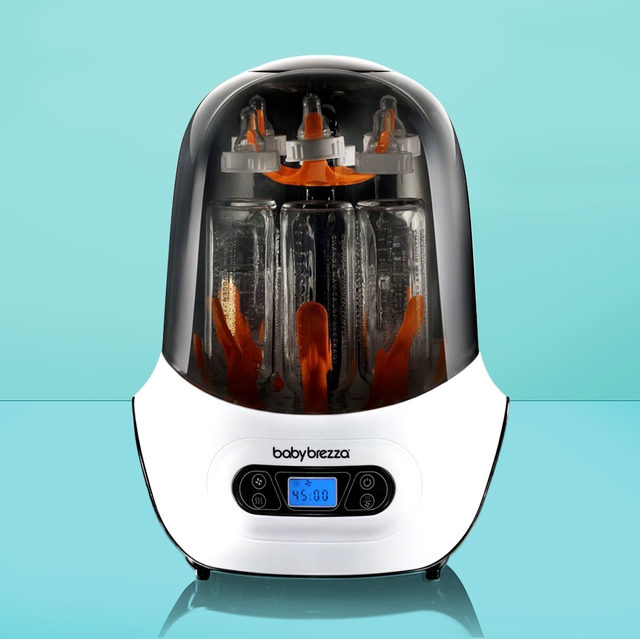
We've been independently researching and testing products for over 120 years. If you buy through our links, we may earn a commission. Learn more about our review process.
The engineering experts at the Good Housekeeping Institute test all of the latest and greatest gadgets for all of your parenting needs, from baby monitors to kid's toys . To find the best baby bottle sterilizers, our engineers in the Little Lab considered how easy they were to use, how long they took to operate, how easy they were to clean, and the number of bottles they can hold. Over the past four years, our engineering pros (and parents!) logged tens of thousands of hours sterilizing bottles and accessories! We also we relied on user reviews and feedback to pick the top-rated sterilizers. Here are our top-picks for saying bye-bye to germs fast:
- Best Overall Bottle Sterilizer : Baby Brezza One Step Sterilizer Dryer
- Best Value Bottle Sterilizer: Munchkin Steam Microwave Sterilizer
- Best Microwavable Bottle Sterilizer: Philips Avent Microwave Steam Sterilizer
- Best Electric Bottle Sterilizer: Dr. Brown’s Electric Steam Sterilizer
- Best Bottle Sterilizer for Travel: Medela Quick Clean Micro-Steam Bags
- Best Bottle Sterilizer for Multiples: Tommee Tippee Electric Steam Sterilizer
- Best Bottle Sterilizer/Dryer Combo: Wabi Baby Electric Steam Sterilizer and Dryer
Do I really n eed a bottle sterilizer?
While it is a personal choice for your family, the Centers for Disease Control and Prevention (CDC) recommends sterilizing bottles and parts once a day, especially for babies younger than three months, born prematurely, or have a weakened immune system. Although not mandatory, it is recommended to always sterilize new bottles before using them and if your doctor has recommended sterilizing bottles between feedings, you might like the convenience of being able to load and run a sterilizer without needing to boil water every time, especially if you have multiple babies.
Hand washing bottles with hot water and soap or running them through the dishwasher gives them a good cleaning but may not appropriately sanitize, while most sanitizers claim to eliminate 99.9% of bacteria, helping to alleviate the potential for serious illness. You can certainly sanitize your bottles using boiling water on the stovetop, but it does get tedious and is time-consuming. While you don't need a dedicated machine to sanitize, having a bottle sterilizer on hand certainly provides convenience, kills germs, and adds some peace of mind. We say that is a win-win for all.
Baby Brezza Baby Bottle Sterilizer and Dryer Machine Combo
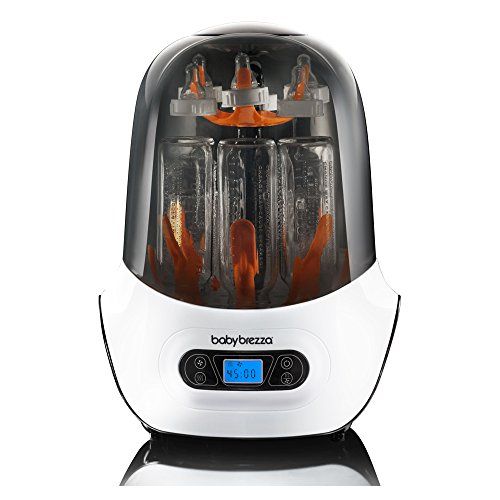
Sterilizing baby bottles and accessories can't get any easier than with the Baby Brezza One Step Sterilizer Dryer. This electric appliance automatically uses natural steam to kill 99.9% of the germs in bottles, breast pump parts, pacifiers, and other baby accessories in just eight minutes, then automatically dries in your choice of a 30, 45, or 60-minute drying cycle. Our Lab pros love that it can be set to automatically sterilize and dry in one cycle, or you can do each independently. It has an easy-to-use control panel and can hold up to six bottles of all shapes and sizes, plus accessories.
Munchkin Steam Guard Microwave Bottle Sterilizer
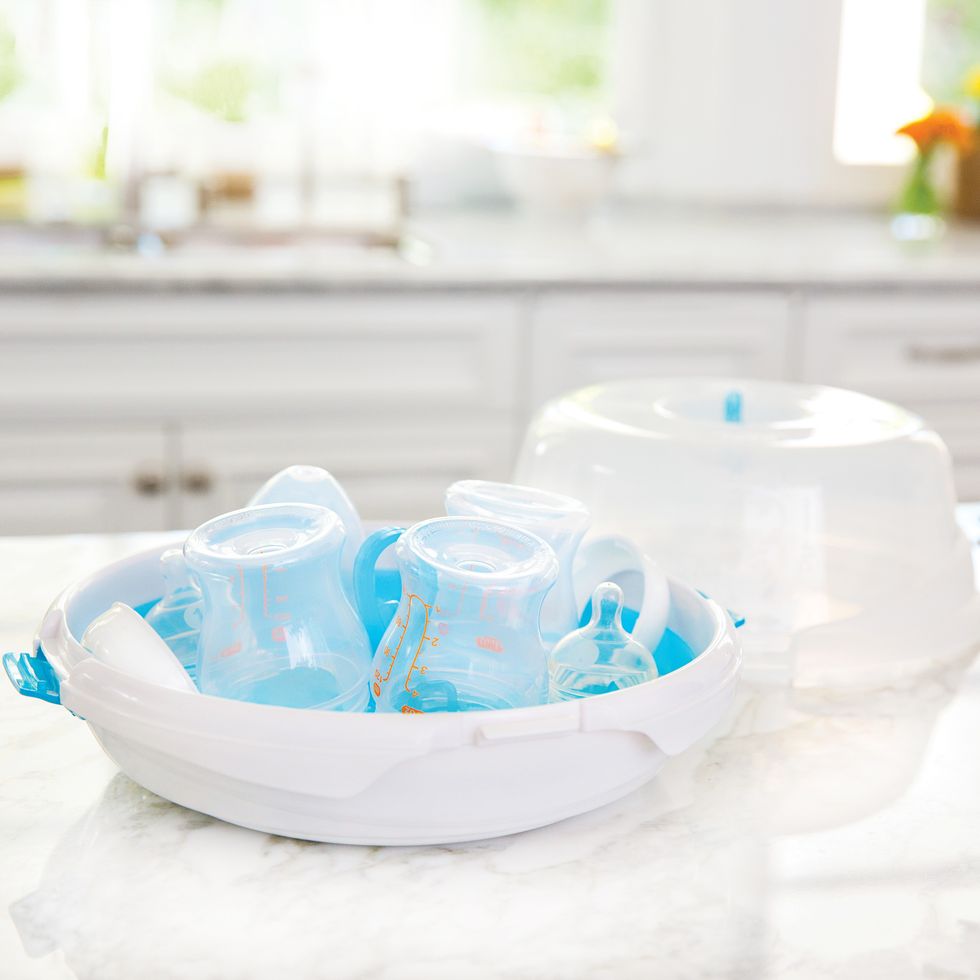
As one of the most affordable options out there, this steam bottle sterilizer is not only wallet-friendly, but simple to use and works in under two minutes. It is also a great option for those that don't want another appliance on their countertop. This microwave sterilizer is a safe and efficient way to kill up 99.9% of bacteria on bottles, nipples, pacifiers, teethers, small toys and breast pump accessories right in your microwave . It's that easy. In our Lab evaluations, we found it lightweight and compact, and we appreciated that it has locking heat-resistant handles to help prevent accidents.
Philips Avent Microwave Steam Sterilizer
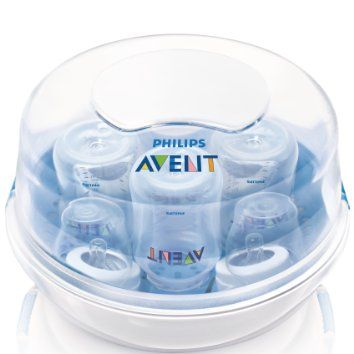
Budget-friendly, fast, and effective, this microwave sterilizer claims to be BPA free and kill 99.9% of bacteria in under two minutes. It can hold up to four different sized bottles, breast pump parts, and feeding accessories. It fits into most microwaves and will keep everything clean for 24 hours if you keep the lid closed. Our engineers and parents noted loving that the handles stay cool, so parents or caregivers can safely remove it from the microwave without any harm.
Dr. Brown's Deluxe Electric Bottle Sterilizer
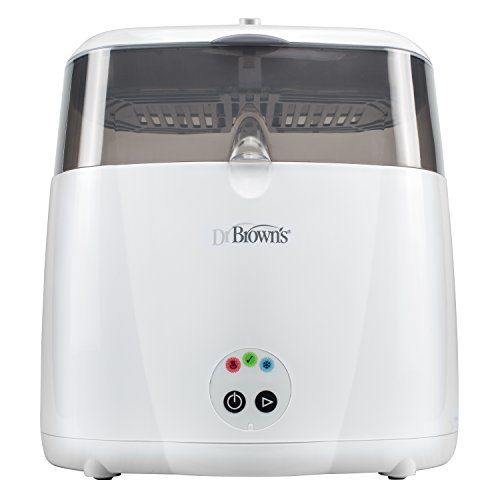
As one of the largest electric sterilizers on the market, this sleek machine has a spacious interior that holds up to six bottles on an upper tray and has a removable lower tray to hold accessories like nipples, breast pump parts, pacifiers, and toys. In just 12 minutes, it will zap 99.9% of germs and automatically shuts off when the cycle is complete. It also comes with a measuring cup and tongs to ensure you won't get burned if you reach in to remove items while they're still hot.
Medela Quick Clean Micro-Steam Sterilizing Bags
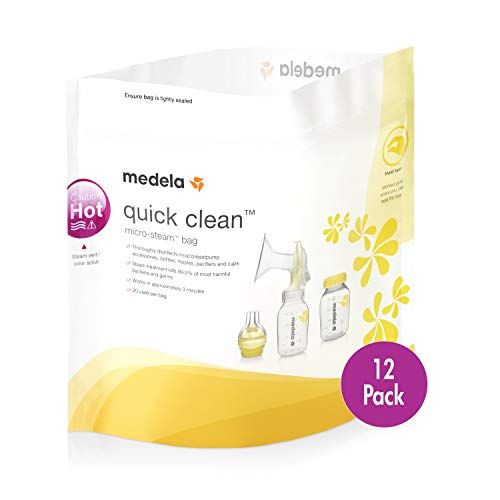
If you want something with no-fuss, easy to use, and great for on-the-go, try the Medela steam bags for all of your bottle sterilizing needs. They're affordable (each steamer bag can be reused up to 20 times) and can be compactly stashed in your diaper bag if you need to sterilize while of the house. Simply add bottles, pump parts, or accessories with water to the bag and pop it in the microwave for about two and a half minutes. Parents love these bags even when in the house, as they don't take up any counter space and are so easy to use. They come in a 12- or 15-pack for under $20. Our Lab team notes it's important to check your microwave specifications to determine the appropriate time to run your microwave for effective results.
Tommee Tippee Steri-Steam Electric Steam Sterilizer
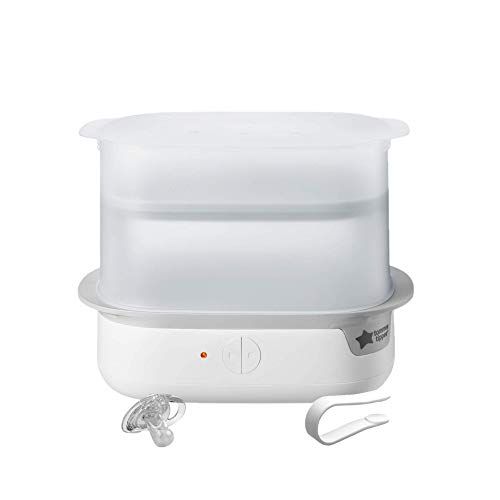
Perfect for multiple kids, sterilize up to six bottles in just five minutes with one push of a button. The Tommee Tippee Steam Electric Sterilizer uses only natural steam to zap 99.9% of germs that may linger in baby bottles, nipples, pump parts, and toys. You'll love its compact design with two stackable trays that have enough space to fit a wide range of bottles and all of your accessories. Bottles will remain sterile for up to 24 hours sealed, so set it and forget it. We love that you can place nipples in the top rack with rings and lids already on for quick assembly once they've been sterilized.
Wabi Baby Baby Electric Steam Sterilizer and Dryer Combo
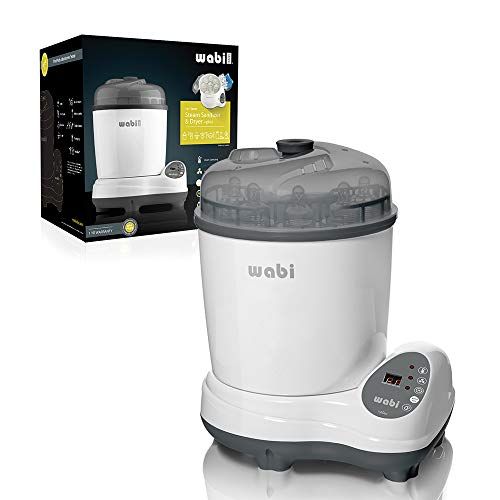
If budget isn't a factor, this electric sterilizer and dryer combo does it all. According to the manufacturer, you can sterilize up to eight bottles, plus accessories, and kill 99.9% of harmful bacteria in 8-15 minutes. It offers three different functions with the simple touch of a button: Sterilizing in as little as eight minutes, drying that leaves bottles condensation-free and ready for use from 30 minutes to 60 minutes, and descaling to take care of hard water and calcium deposits, a common issue with steam bottle sterilizers.
It has a smart sensor that shuts the unit off automatically when it's done sterilizing, and it also has a countdown timer so you can track how much longer it will take. Bottles will stay clean for up to 24 hours with a closed lid, so you can set it up the night before and wake up to sparkling bottles ready for your baby.
How to find the best baby bottle sanitizer for you
When choosing your sterilizer, consider how many bottles you'll want to clean at once, the cost, how much counter space you have, and if it would be easier to have an all-in-one device that dries and stores or a simple unit that fits in the microwave when you need things cleaned. Some also include dryers, for an added bonus.
If you choose to use a bottle sterilizer for your baby's bottles, there are two ways to go about it — microwave or electric . Both types use the steam to kill approximately 99.9% of harmful bacteria in just a few minutes, so it's simply a matter of personal preference which one you should choose, and they are both safe and effective given the right devices. Here's a breakdown:
- Electric steamer sterilizer: Simply plug it in and let the machine do all the work. In an electric sterilizer, the bottles and parts are cleaned at a high temperature to produce steam. Electric sterilizers come in many shapes and sizes, depending on your needs and countertop real-estate.
- Microwave sterilizer: Easy and effective, microwave sterilizers can efficiently sanitize baby bottles and accessories in under two minutes. They come either in steam bags or in plastic containers. Just add water, and pop it right into the microwave for quick sanitizing.
Ali Kessler is a native New Yorker residing in the Sunshine State with expertise in hospitality, travel, the beauty industry, and electronics. She is a writer by nature, a graphic designer by study, a chef for fun, and a digital marketer by choice. Ali earned her Bachelor of Science in Advertising and English from the University of Florida. She then earned her graduate certificate from the Art Institute of Ft. Lauderdale in Graphic Design and a Digital Marketing Degree from Full Sail University. Ali has touched on all aspects of marketing/advertising, from logo creation to traffic, copywriting, web design, content writing, and getting social. Advertising has always been her passion ever since she watched Angela Bower on Who’s the Boss. Ali spends her free time with her four-year-old son making forts and pillow ice cream shops.

@media(max-width: 64rem){.css-o9j0dn:before{margin-bottom:0.5rem;margin-right:0.625rem;color:#ffffff;width:1.25rem;bottom:-0.2rem;height:1.25rem;content:'_';display:inline-block;position:relative;line-height:1;background-repeat:no-repeat;}.loaded .css-o9j0dn:before{background-image:url(/_assets/design-tokens/goodhousekeeping/static/images/Clover.5c7a1a0.svg);}}@media(min-width: 48rem){.loaded .css-o9j0dn:before{background-image:url(/_assets/design-tokens/goodhousekeeping/static/images/Clover.5c7a1a0.svg);}} Children's Items & Toys

The Best Gifts for 6-Year-Old Boys

The Best Toys and Gifts for 6-Year-Olds
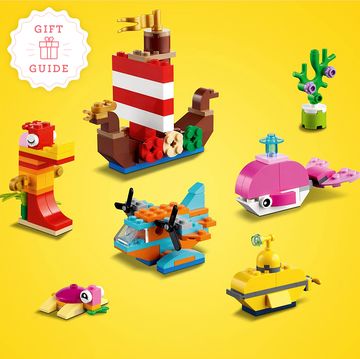
The Best Toys and Gifts for 5-Year-Old Boys
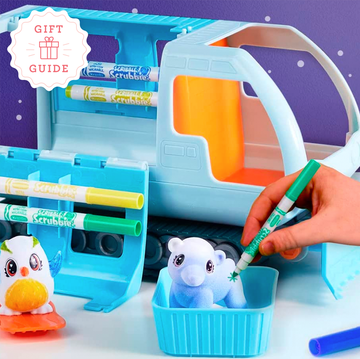
The Best Gifts for 4-Year-Old Girls
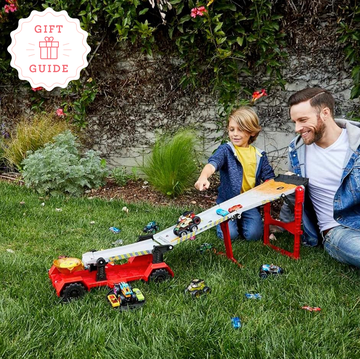
The Best Toys and Gifts for 3-Year-Old Boys
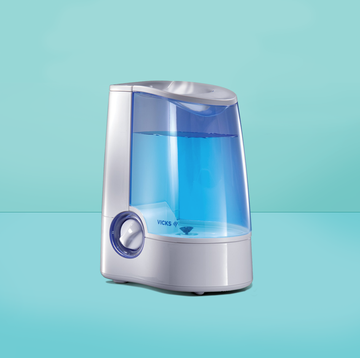
The Best Humidifiers for Babies
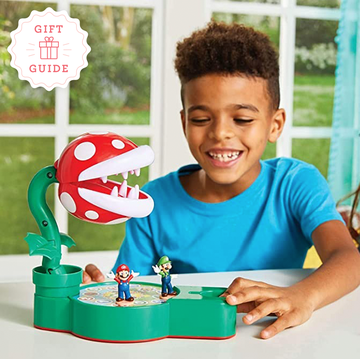
The Best Gifts for 7-Year-Old Boys
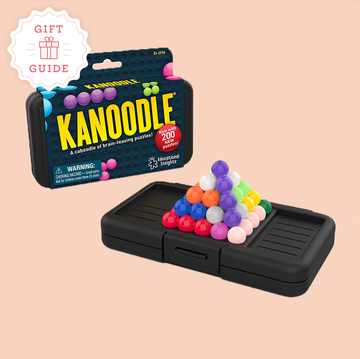
The Best Toys and Gifts for 7-Year-Olds

Best Toys and Gifts for 6-Year-Old Girls
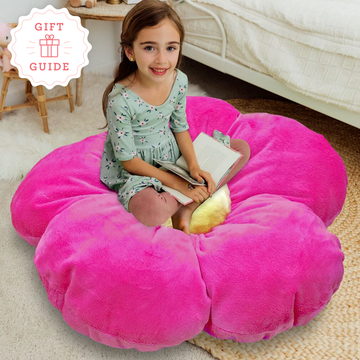
Best Gifts for 5-Year-Old Girls
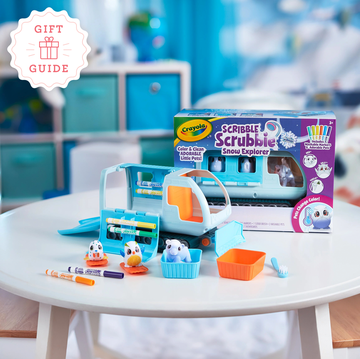
The Best Gifts for 5-Year-Olds
Ad-free. Influence-free. Powered by consumers.
The payment for your account couldn't be processed or you've canceled your account with us.
We don’t recognize that sign in. Your username maybe be your email address. Passwords are 6-20 characters with at least one number and letter.
We still don’t recognize that sign in. Retrieve your username. Reset your password.
Forgot your username or password ?
Don’t have an account?
- Account Settings
- My Benefits
- My Products
- Donate Donate
Save products you love, products you own and much more!
Other Membership Benefits:
Suggested Searches
- Become a Member
Car Ratings & Reviews
2024 Top Picks
Car Buying & Pricing
Which Car Brands Make the Best Vehicles?
Tires, Maintenance & Repair
Car Reliability Guide
Key Topics & News
Listen to the Talking Cars Podcast
Home & Garden
Bed & Bath
Top Picks From CR
Best Mattresses
Lawn & Garden
TOP PICKS FROM CR
Best Lawn Mowers and Tractors
Home Improvement
Home Improvement Essential
Best Wood Stains
Home Safety & Security
HOME SAFETY
Best DIY Home Security Systems
REPAIR OR REPLACE?
What to Do With a Broken Appliance
Small Appliances
Best Small Kitchen Appliances
Laundry & Cleaning
Best Washing Machines
Heating, Cooling & Air
Most Reliable Central Air-Conditioning Systems
Electronics
Home Entertainment
FIND YOUR NEW TV
Home Office
Cheapest Printers for Ink Costs
Smartphones & Wearables
BEST SMARTPHONES
Find the Right Phone for You
Digital Security & Privacy
MEMBER BENEFIT
CR Security Planner
Take Action
Best Baby Bottle Sterilizers of 2024
We tested bottle sterilizers from Baby Brezza, Hauture, Papablic, and other brands to find the ones that are easiest to use and most effective in getting bottles clean
When you shop through retailer links on our site, we may earn affiliate commissions. 100% of the fees we collect are used to support our nonprofit mission. Learn more .

As a new or expectant parent, there’s a lot of joy and excitement in welcoming a baby home—but some worry, too. You’ve done everything you know to keep your baby safe: baby-proofed the home, researched the safest car seats , and bought a crib sturdy enough to withstand an earthquake. And when it comes to nursing and feeding, you want to be just as vigilant. That’s why we tested steam-based baby bottle sterilizers and spoke with experts to find the ones that will keep germs—and your worries—at bay.
In This Article
Best Baby Bottle Sterilizers • One Bottle Sterilizer to Avoid • How We Test • Do You Need a Bottle Sterilizer? • How to Choose a Bottle Sterilizer • How to Use a Sterilizer
Steam baby bottle sterilizers are countertop appliances that use heat to kill germs on baby bottles. The process gets them far cleaner than just hand-washing the bottles or using a normal dishwasher cycle, which mostly washes germs away rather than killing them. That’s enough to get rid of the most potentially harmful types of germs, but microscopic organisms still remain. By using a bottle sterilizer, you can actually kill the vast majority of those organisms.
Despite their name, these devices don’t actually sterilize your bottles, but sanitize them. Sterilization is a process that reduces microorganisms to undetectable levels. Steam sterilization in an autoclave, for example, requires steam at 250° F for 30 minutes. Sanitization with steam, on the other hand, uses high-enough heat to kill a minimum of 99.9 percent of bacteria (and, as with sterilizing, most fungi and molds).
Best Baby Bottle Sterilizers
The following baby bottle sterilizers are the ones that performed best in our tests and are recommended by CR’s experts. You can see more models and details on their performance in our bottle sterilizer ratings .
A Baby Bottle Sterilizer to Avoid
We recommend skipping the Grownsy Baby Bottle Sterilizer and Dryer . The manufacturer says it should run an 8-minute cycle, but when we tested it in our lab, the sterilizer stopped heating the water reservoir after a mere 90 seconds, and the interior of the sterilizer reached only 130° F. We bought a second model to re-test, and this second sample performed as expected based on the product’s claims, providing heat to the water reservoir for 8 minutes and bringing the sterilizer to a maximum temperature of 198° F. But when we purchased a third sterilizer for a third test, the item heated the water reservoir for less than 3 minutes, reaching a maximum temperature of only 150° F. Compared with other brands whose products worked as expected and reached temperatures above 180° F without issue, we believe the Grownsy sterilizer may not provide safe bottles for vulnerable infants.
When we reached out to the company, Grownsy told CR that premature machine shutdown is not a malfunction and that in case of premature shutdown, users can restore normal operation by applying toothpaste to the heating plate, adding 60 milliliters of water, and allowing it to boil dry. The company advises repeating this process three times. CR has not confirmed the effectiveness of this process, though, because we believe products should work as intended out of the box.
Any consumers that experience issues can contact the company through [email protected] . The company also said that it has "conducted comprehensive testing on all unsold products to ensure enhanced user experience."
If you own a Grownsy sterilizer that doesn’t perform well and the steps they provided to fix it don’t work, Grownsy told us you can reach out to the company for a free replacement.
How CR Tests Baby Bottle Sterilizers
Our lead test engineer for bottle sterilizers, Bernie Deitrick, scored the models we tested on three metrics: temperature performance, drying performance, and ease of use.
To test each sterilizer, we added the amount of distilled water specified by the manufacturer’s instructions to the sterilizer’s reservoir and ran its sterilization cycle with a mixed load of plastic and glass baby bottles. Using a thermocouple probe to monitor the temperature inside the sterilizer, we assessed temperature performance based on the amount of time the sterilizer maintained a temperature above 180° F, a temperature capable of heating the interior of the bottles enough to kill most germs, says Deitrick. All the models that exceeded 180° F passed the test, but the sterilizers that reached higher temperatures—and especially those that maintained those high temperatures for longer—received higher scores.
Because all the models we tested had fans, we assessed how dry the bottles were at the end of the drying cycle. Bottles and sterilizers that were completely dry by the end of the cycle received the highest score for that test.
In terms of ease of use, we evaluated how simple the sterilizers were to operate and how easy it was to load and unload bottles and other items in the trays. The best sterilizers were intuitive when it came to both operating and loading, easily accommodated a full load of bottles, and the bottles stayed in place throughout the cycle.
Do You Really Need a Bottle Sterilizer?
The Centers for Disease Control and Prevention says sanitizing baby bottles is important for babies up to 2 months old, and for babies with weak immune systems (for instance, if they’re premature or suffer from an illness or autoimmune disease, or if they undergo medical treatments that weaken the immune system, like chemotherapy).
Most babies older than 2 months will have built a strong enough immune system that will make them less susceptible to getting sick from bacteria and other microbes. At that point, cleaning bottles with the dishwasher set at its standard cycle—or scrubbing by hand with soap and hot water (with a bottle brush or other clean tool) and then air-drying—is fine, says Kelly Reynolds, PhD, director of the Environment, Exposure Science and Risk Assessment Center at the University of Arizona in Tucson.
These baby bottle sterilizers are certainly a convenient choice, but they’re not the only way to sanitize bottles. A dishwasher with a sanitizing cycle (make sure it’s certified by the NSF , formerly the National Sanitation Foundation) can also adequately sanitize baby bottles.
You can also sanitize baby bottles by submerging them in a big pot of water, boiling for 5 minutes, then air-drying. Or, per the CDC, you can soak bottles for 2 minutes in a gallon of water mixed with 2 teaspoons of bleach, then air-dry.
How to Choose a Baby Bottle Sterilizer
Most steam sterilizers are tall, boxy receptacles powered by an electric heating system. But there are a few features that vary from model to model. Here’s what to consider:
- Fit: Most products can accommodate several shapes and sizes of baby bottles, but some work best using shorter bottles. For instance, many models have a tray for nipples and accessories that sits above the bottle tray, but the upper tray won’t fit under the sterilizer lid if you’re using tall baby bottles, so you may need to run additional items in a separate cycle.
- Trays: All models have at least one tray to hold baby bottles in place (upside-down so that they dry thoroughly). Some have an extra tray for the nipples and other small items, such as pacifiers.
- Prongs: Some products have long prongs that keep the bottles stable. Others have very short prongs that make the bottles a little more unwieldy, but it makes the bottle tray more flexible in terms of what you can load in it.
- Fans: Some models have a fan that draws air through a filter to help dry the bottles faster—typically within an hour. Others don’t have fans, so you’ll need to air-dry, which can take several hours. (The models we tested all have a fan-assisted drying cycle.)
- Filters: Some models have HEPA filters, to reduce the possibility of re-contamination by the air that is blown over the bottles during the drying cycle.
How to Use a Bottle Sterilizer
Products might vary, but generally speaking, start by washing and rinsing your bottles thoroughly in the sink or a regular dishwasher cycle to get rid of all food residue. Then load them into the sterilizer, add water to the sterilizer’s reservoir, and turn it on. The sterilizer heats the water in the reservoir to create the steam that kills germs. Bottle sterilizer cycles are fast, usually taking around 10 minutes or less to sanitize. Some have fans for drying cycles, which can take up to 60 minutes to dry the bottles, though some claim to take considerably less time.
A Note on Heating Plastic Bottles
If you want to use a sterilizer, the microwave, or the hot cycle on your dishwasher, these are best paired with bottles that are glass or silicone.
That’s because when plastic is heated to high temperatures, it can leach chemicals and release microplastics . If you do sterilize plastic bottles, rinsing the inside of the bottle with water that has been boiled and cooled after the sterilization step may reduce the level of microplastics, says John Boland, PhD, professor of chemistry at Trinity College Dublin and author of a 2020 research paper (PDF) on the topic.
Read more about how to reduce the risk of potentially harmful chemicals, including BPA and phthalates, in baby bottles .
Molly Bradley
Molly Bradley is a home and appliance writer at Consumer Reports. Before joining CR in 2023, she managed the editorial team at Digg, and has devoted her career to helping readers navigate the world and make their lives a little easier, elucidating topics in technology and culture. Molly earned a master’s degree in writing from Bennington College and lives in Brooklyn, N.Y., with her cat, Saltine. Follow her on X @mollyguinn .
Sharing is Nice
We respect your privacy . All email addresses you provide will be used just for sending this story.
Tommee Tippee Steridryer Electric Steam Sterilizer & Dryer 52228520
Dr. brown's bottle sterilizer and dryer ac177, babymoov turbo pure sterilizer & dryer, wabi electric steam sterilizer, grownsy baby bottle sterilizer and dryer, hauture baby bottle sterilizer, papablic electric steam sterilizer, philips avent advanced electric steam sterilizer scf29300, baby brezza baby bottle sterilizer advanced, baby brezza one step baby bottle sterilizer.
See All Ratings
Trending in Baby Bottle Sterilizers
The Best Bottle Sterilizers to Keep Things Germ-free
Worried about germs on your bottles or pump parts sterilizers kill 99.9% of bacteria in minutes., by jen labracio.

Kids + germs: it’s inevitable. Babies love to put anything and everything in their mouths, the dirtier the better. But when you’re talking about bottles (and pacifiers](/hello-baby/best-pacifiers), and breast pump parts , and even some toys and teethers ), ensuring they’re as germ-free as possible can offer some peace of mind. And that’s where a bottle sterilizer comes in.
Babylist’s Top Picks for the Best Bottle Sterilizers
- Best Bottle Sterilizer with Faster Drying: Baby Brezza One Step Baby Bottle Sterilizer Dryer Advanced
- Best Affordable Bottle Sterilizer: Philips Avent Microwave Steam Sterilizer
- Most Spacious Bottle Sterilizer: Dr. Brown’s Electric Steam Sterilizer
- Best for On-the-Go Sterilizing: Munchkin Jumbo Microwave Bottle Sterilizer Bags
- Best Compact Bottle Sterilizer: Chicco 3-in-1 Steam Sterilizer
- Best Portable Sterilizer for Small Parts: Munchkin Mini Portable UV Sterilizer
In This Article
How we chose our best bottle sterilizers, do you need a bottle sterilizer, types of bottle sterilizers, faster drying.
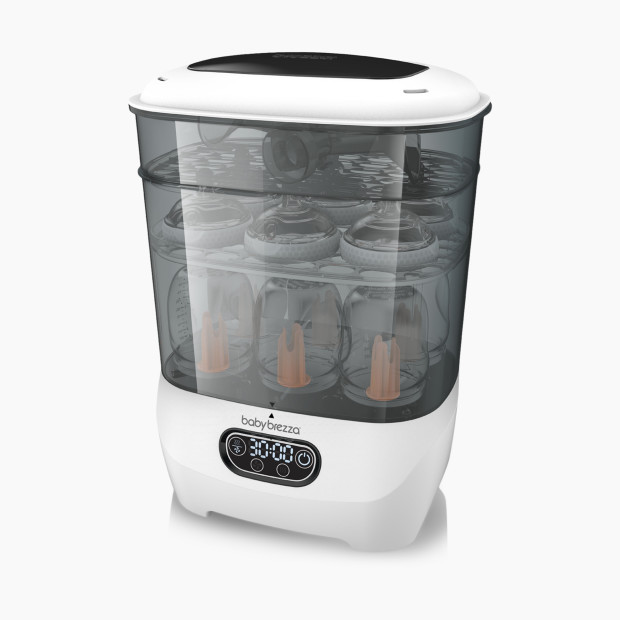
Baby Brezza One Step Baby Bottle Sterilizer Dryer Advanced - White
This electric sterilizer packs a two-in-one punch: it uses natural steam to sterilize bottles, pump parts and more, and features a drying function that’s 33% faster so your gear comes out completely clean and dry with no leftover moisture to encourage bacteria or mold growth. The Brezza One Step Advanced holds up to eight bottles at a time and two complete pump part sets and has an easy-to-use LCD control panel with four different functions.
Looking to spend a bit less? Check out Baby Brezza’s One Step Sterilizer Dryer . It holds two less bottles than the Advanced and has a slightly longer drying time but is still a great option.
Budget Friendly
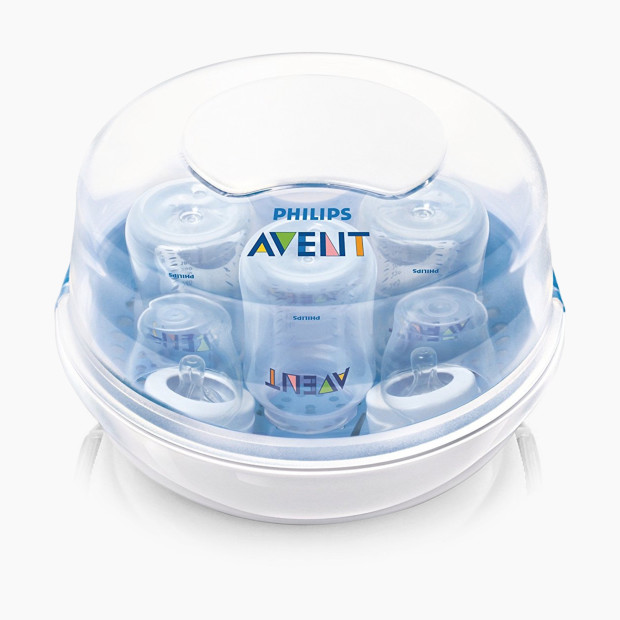
Philips Avent Microwave Steam Sterilizer
At a fraction of the cost of other sterilizers, this microwave option is roomy, compact and easy to use. It fits four 9-ounce bottles and is compatible with both standard and wide-neck designs. Everything inside remains sterile for up to 24 hours if you keep the stay-cool latches closed.
Quick and Roomy
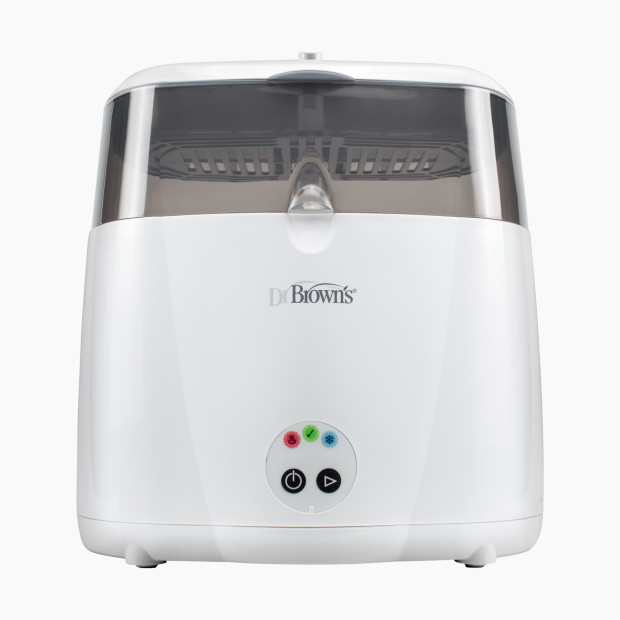
Dr. Brown's Electric Steam Sterilizer - Gray
In just 12 minutes, this electric sterilizer kills 99.9% of germs and automatically shuts off when the cycle is complete and your items are clean and ready to go. The spacious interior holds up to six bottles on an upper tray and has a separate lower tray to hold accessories like nipples and pacifiers. Included tongs ensure you won’t get burned if you reach in to remove items while they’re still hot.
It’s worth noting that this sterilizer requires distilled water; otherwise, mineral deposits can build up on the heating unit and flake off.
Great for On the Go
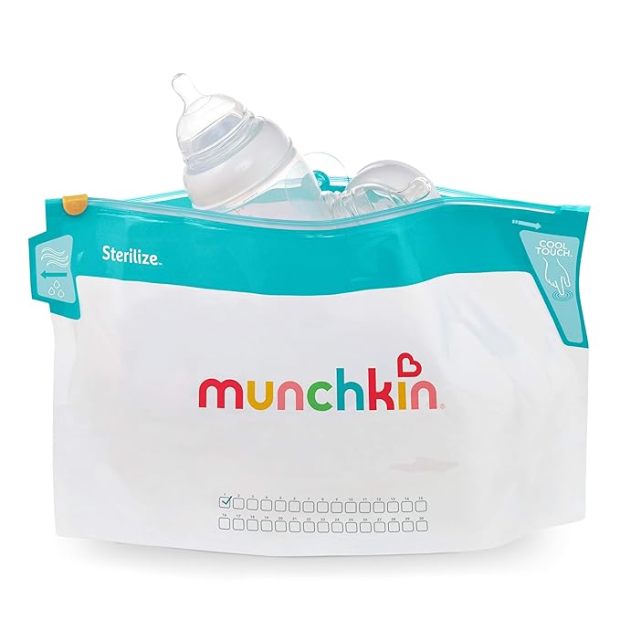
Munchkin Microwave Bottle Steam Sterilizer Bags
Want to sterilize when you’re not at home? Microwave steam bags are a great option. Simply fill one of these XL bags with whatever items you need cleaned and a little bit of water, pop it in the microwave and you’re good to go. This set includes six bags and each bag can be used up to 30 times. There’s even a spot to mark each steam cycle so you can keep track of how many times you’ve used them.
Countertop Friendly
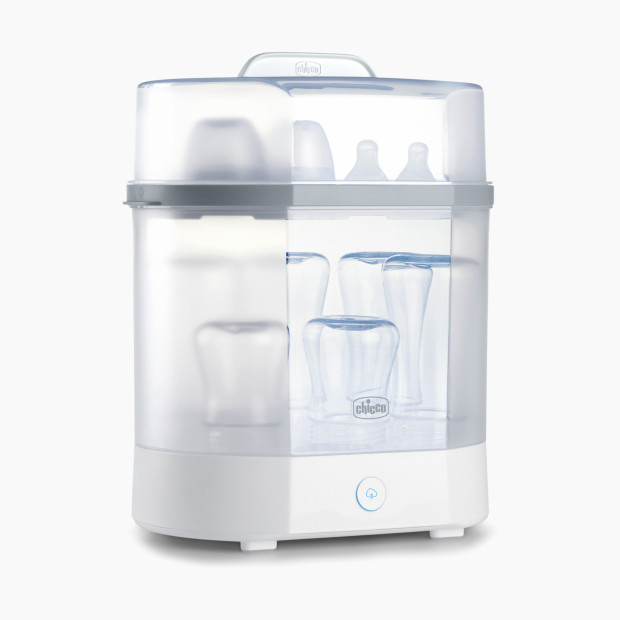
Chicco 3-in-1 Steam Sterilizer - White
Using the power of steam, this Chicco sterilizer features a versatile, modular design with full-size, compact and microwave options for sterilizing. Its full size doesn’t take up much counter space and still fits up to six bottles and their parts. The compact mode is great for sterilizing smaller parts and feeding accessories and for super fast sterilizing, you can pop its designated pieces in the microwave. It has a coated heating plate that prevents mineral residue from building up and also has an automatic shut off for safety.
Portable UV Light Power
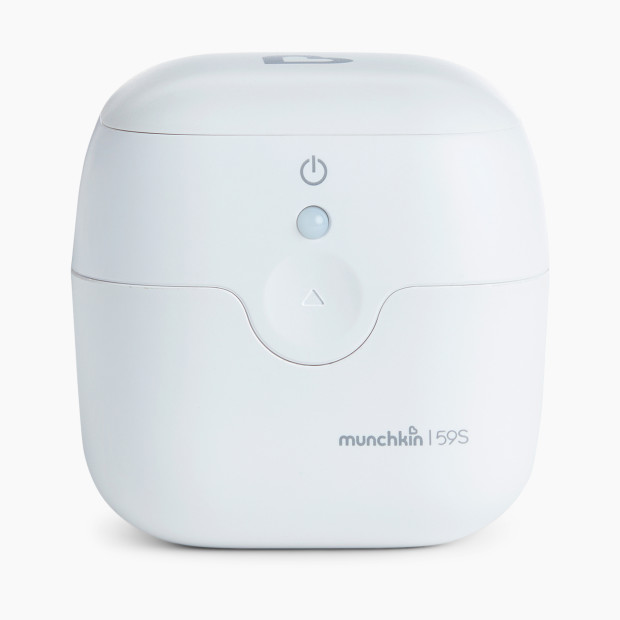
Munchkin Mini Portable UV Sterilizer
Just note that this sterilizer won’t work for bottles—it’s too small for that. It does work really well for all of those items your baby loves to drop on the ground when you’re out and about, though, like pacifiers, nipples, teethers and other small toys.
While the other sterilizers on our list use steam sterilization systems, this one is powered by UV light. This means way less time (one cycle takes only 59 seconds!) and no leftover water residue to worry about. It’s also ultra-portable; it easily fits in a purse or a diaper bag and comes with a strap if you want to attach it right to your stroller or bag. It’s powered by 3 AA batteries or can be plugged in via a USB wall socket (the cable’s included).
We asked thousands of real Babylist families about the baby products they love the most, then took the top products they shared with us and added our own research and insight to tell you about the best bottle sterilizers.
Hand washing bottles with soap and hot water or running them through the dishwasher is more than sufficient for keeping your bottles and other baby gear clean and free of breast milk or formula . Sterilizing is an extra step that’s often recommended for parents of immunocompromised or premature babies, but it’s also something some parents choose to do either regularly or once in a while to keep frequently used items extra clean.
If you do choose to sterilize your baby’s bottles, there are a few ways to go about it:
- boiling them in hot water for five minutes
- using a microwave steam sterilizer bag
- using a bottle sterilizer
Like a bottle warmer , it’s a convenience you may or may not want to add to your arsenal of baby stuff.
Most sterilizers come in two types—microwave or electric. Both use steam to kill 99.9% of harmful bacteria in just a few minutes, so it’s just a matter of personal preference which one you should choose.
UV light sterilizers are also starting to become a popular sterilizing option. These types of sterilizers use UV light to eliminate germs by breaking down their DNA at the molecular level.

Jen LaBracio
Senior gear editor.
Jen LaBracio is Babylist’s Senior Gear Editor, a role that perfectly combines her love of all things baby gear with her love of (obsessive) research. When she’s not testing out a new high chair or pushing the latest stroller model around her neighborhood, she likes to run, spin, listen to podcasts, read and spend time at the beach. In her past life, she worked for over a decade in children’s publishing. She lives outside of Chicago with her husband and their two boys, Will and Ben.
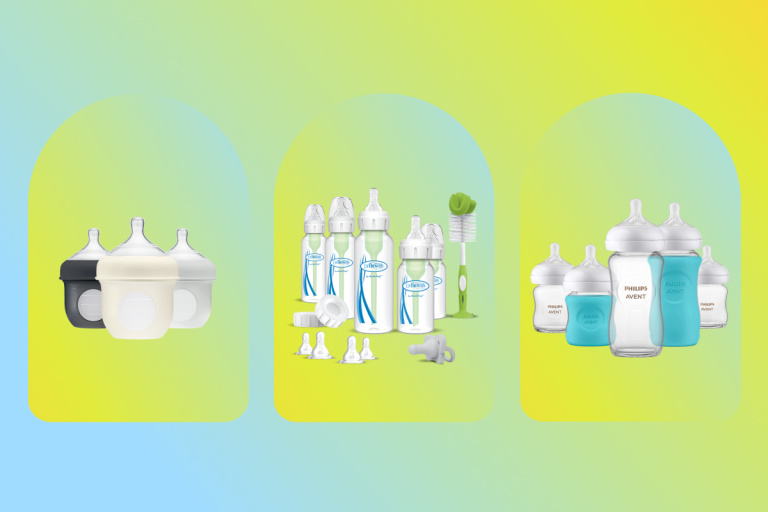
6 Best Baby Bottle Sterilizers, According to Moms
Fact-checking standards, latest update:, how we chose the best bottle sterilizers , other factors to consider when buying bottle sterilizers, how often do i need to sterilize baby bottles, is a sterilizer necessary for baby bottles, how do i sterilize a baby bottle, when can i stop sterilizing baby bottles, why trust us, best overall bottle sterilizer, tommee tippee supersteam electric steam sterilizer, best microwave bottle sterilizer, philips avent microwave steam sterilizer, best splurge bottle sterilizer, baby brezza one-step baby bottle sterilizer dryer, best travel sterilizer, medela quick-clean micro-steam bags, best budget bottle sterilizer, munchkin steam guard microwave sterilizer, best bottle sterilizer and warmer, dr. brown’s deluxe bottle warmer & sterilizer.
WhatToExpect.com, When and How Should I Sterilize Baby Bottles? , August 2022. American Academy of Pediatrics, How to Sterilize and Warm Baby Bottles Safely , August 2018. Centers for Disease Control and Prevention, How to Clean, Sanitize, and Store Infant Feeding Items , February 2023. National Library of Medicine, Buying and caring for baby bottles and nipples , May 2021.
Explore the Best Products for Moms and Babies
Trending on what to expect, best baby deals happening right now, how to get your registry's free welcome gift, ⚠️ you can't see this cool content because you have ad block enabled., 17 of the best baby bottle and breast milk storage solutions you can buy on amazon, best toddler water tables, best stroller fans.
- Skip to main content
- Skip to main navigation
- Skip to search
Advertisement
Our writers test and research products independently. When you buy through a link on our site we may earn a commission but this never affects our product choices.
Best sterilisers for baby bottles, breast pumps and more
Whether electric, microwave, cold water or travel sterilisers suit you best, you’ll find tips and top scorers aplenty on this page. Here we reveal the best sterilisers to buy in 2024.
By Rachel Jeffcoat | Last updated Mar 8, 2024

In the hazy days with a new baby, keeping them safe is the number one priority – and also likely to be the biggest source of anxiety for parents. A steriliser can be used to kill bacteria found on lots of different baby feeding equipment like baby bottles, teats and breast pump parts. But which is the best steriliser to make your feeding schedules easier to juggle? After our latest intensive round of testing, we’ve got all the information you’ll need about our favourites.
It's been Mumsnet's mission to make parents' lives easier for over 20 years, so we know how much difference choosing the right product can make. That's why we obsessively research, review and vet everything we recommend - from the best breast pumps to the best changing bags .
We commissioned Rachel Jeffcoat, a writer and mum of three, to research and review the top sterilisers out there. As a parent to an eight-, six- and two-year-old, all of whom were combination-fed as babies, Rachel has years of experience using a wide variety of baby equipment, including sterilisers. As a writer, she’s written extensively on parenthood, including Mumsnet’s reviews on the best baby sleeping bags and the best baby bottles . After in-depth research and parent-led testing, we have the results.
Here are the best sterilisers to buy right now.
Best sterilisers at a glance
Best overall steriliser: Tommee Tippee Super Steam Advanced Electric Steriliser
Best budget steriliser: Medela Quick Clean Microwave Bags
Best cold water steriliser: Milton Cold Water Steriliser
Best travel steriliser: Milton Solo Travel Steriliser
Best large steriliser: Dr Brown’s Deluxe Electric Steam Steriliser
Best steriliser for drying: Nuby Natural Touch Steriliser and Dryer
Tommee Tippee Super-Steam Advanced Electric Steriliser
Takes up very little space on the kitchen counter
Sturdy and safe materials and design
Inexpensive to run
Large capacity
Simple interface to use with rapid sterilisation cycle
Not the most budget-friendly electric steriliser we tested, and a more expensive initial outlay than microwave or travel versions
Doesn’t fit extra-tall bottles, like Dr Brown’s
Doesn’t have any extra features – just a simple sterilisation cycle
Price: £50 | Capacity: Approximately six bottles | Materials: BPA-free plastics and metal electrical components | Included: Steriliser and teat tongs – larger sets are also available to buy
Tested by Mumsnet: Read our full Tommee Tippee Super Steam Advanced Electric Steriliser review
Tommee Tippee has put a great deal of thought into the redesign of their electric steam steriliser and it really shows. The Tommee Tippee Super-Steam Advanced Electric Steriliser is made from tough BPA-free plastics and is exceptionally straightforward to use, with plenty of room for bottles and breast pump parts over two tiers.
It takes one touch of a button to start a cycle and, if you have any accompanying Tommee Tippee bottles, each bottle is clearly marked to show how much water to add to the steriliser – a thoughtful touch that our tester really appreciated.
The sterilisation cycle is just five minutes, one of the shortest from an electric steriliser we tested. If the lid isn’t removed, everything inside stays sterile for 24 hours after running a cycle. While the initial outlay is more than a microwave steriliser, it’s considerably cheaper to run. Altogether, the Tommee Tippee Super-Steam is a reliable, thoughtfully-designed steriliser that’s widely available, well-supported and should do its job consistently over time – a lifesaver to an overloaded new parent and a worthy winner of this year’s Mumsnet Best Steriliser award.
Good for parents who...
Use Tommee Tippee bottles and other Tommee Tippee baby products
Get through up to six bottles a day
Want an electric steam steriliser but don’t have a lot of kitchen workspace available
Read next: The best highchairs for babies and toddlers
Medela Quick Clean Microwave Bags
They cost about the same as your fortnightly nappy bill, but will last three times longer
Small and portable – great for small kitchens, grandparents’ houses and holidays
Quick three-minute cycle
No assembly, pre-cycle or cleaning required
Each bag can be reused up to 20 times
Can only sterilise two bottles per cycle – so if you’re getting through more than four bottles a day it’s fairly labour-intensive
Requires a microwave to work
No measuring jug included
Price: £11 | Capacity: Two bottles | Materials: BPA-free plastic | Included: 5 bags
Tested by Mumsnet: Read our full Medela Quick Clean Microwave Steriliser Bag review
For parents on a budget that won’t allow for a £50 to £80 outlay, or babies who spend time with grandparents, childminders or away on holiday, Medela's reusable Quick Clean Microwave Bags are reliable, compact and surprisingly good value for money.
The box contains five capacious, well-designed bags that can fit two bottles apiece and each bag can be reused 20 times, so they’re much more economical than they might first appear.
Made from tough plastic with a good seal, a cool marked area to hold the bag without burning fingers, and a hole to pour out the water safely before opening, they’re safe and well-designed. The instructions are printed on each bag and there’s also a tick chart so you can keep track of how many times the bag has been used.
The caveat is that you’ll need a microwave to use them, which might not always be available – and, more importantly, sterilising just two bottles at a time won’t be feasible if you’re bottle-feeding full-time.
Have a small kitchen
Are on a tight budget that doesn’t allow for large outlays in one go
Need to sterilise every day, but not intensively
Read next: The best sippy cups, according to Mumsnetters
Milton Cold Water Steriliser
Can easily be scaled up and down for different quantities of equipment and equipment in awkward shapes
Inexpensive to buy and maintain
Items remain sterile for 24 hours and can be added and removed as necessary
The large bucket should be kept out of reach of children when in use and will take up the sink or a reasonable amount of counter space
The sterilisation fluid smells of chlorine – and so will the baby equipment and your kitchen
Price: £17 | Capacity: Six bottles, plus breast pump parts | Materials: Plastic | Included: Container and weighted grid
Tested by Mumsnet: Read our full Milton Cold Water Steriliser review
Milton’s cold water sterilising solution has retained its foothold in the market for 70 years. It involves dissolving tablets or fluid into a sturdy five-litre container of water and submerging items in it for 15 minutes as per manufacturer instructions. The bucket comes with a locking lid and a weighted grid to keep items submerged. They’ll remain sterile in the solution for 24 hours and more items can be added as and when they’re used.
There’s a simplicity and low-tech flexibility about the Milton Cold Water Steriliser that lends itself well to scaling up for large piles of gear (using the correct number of tablets in any clean container would also work) – one of the reasons it’s popular on maternity wards and with parents of multiple babies. Just make sure you don’t mind the inevitable swimming pool smell – and keep the large bucket out of reach of children as it’s heavy when full.
Have multiple babies, use a lot of bottles per day or want to sterilise a variety of items including breast pumps, toys and dummies
Want a solution that doesn’t affect the energy bill
Related: The best nappy bins to keep your home pong-free
Milton Solo Travel Steriliser
Can be stored in a cupboard when not in use
Keeps items sterile for 24 hours
Can be used in the microwave or with cold water sterilising solution
Short two-minute cycle in the microwave or a 15-minute cycle with cold water
Can fit most bottle brands (though not very tall ones, like Dr Brown’s)
It’s not as roomy as the microwave steriliser bags like the ones made by Philips or Medela, which can usually fit two bottles or a bottle and a breast pump – this fits one or the other
When filled with water, it leaks while on its side
The width of the unit means it’s hard to open when wet or very hot
Price: £11 | Capacity: One bottle | Materials: BPA-free plastic | Included: Steriliser only
Tested by Mumsnet: Read our full Milton Solo Steriliser review
Because travel sterilisers need to be compact enough to carry around, they’re usually short on bells and whistles. What we loved about the Milton Solo was that, travel steriliser or not, it’s more adaptable and comes with more useful design features than any other travel model we tested.
Generously sized for a bottle or breast pump parts, it can be microwaved or used with cold water sterilising solution, whichever works best for where you are. Its width does mean you’ll need both hands to open it though, which can be tricky when it’s hot or wet.
Items inside stay sterile for 24 hours and the lid is designed with a flat lip so it can be laid horizontally in a smaller microwave – a useful feature we didn’t find in any other travel steriliser.
Need a steriliser for travel or to live at a grandparent’s or childminder’s house
Want the flexibility of microwave and cold water sterilisation in one unit
Have a small microwave that wouldn’t fit a steriliser upright
Read next: The best baby bath tubs, tried and tested
Dr Brown’s Deluxe Electric Steam Steriliser
Professional-looking display indicates which stage the cycle is at
Spacious interior for larger bottles
Accessories basket makes it easier to retrieve smaller items
Measuring jug and tongs included
Items inside stay sterile for 24 hours
Eight-minute cycle not the quickest we tested
Short wire limits where it can be placed on the counter
More expensive than some other electric models, like the Tommee Tippee Super-Steam Advanced Electric Steriliser or the Nuby Natural Touch
Price: £110 | Capacity: Six bottles | Materials: BPA-free plastics and metal electrical components | Included: Sterilisation unit, measuring jug and tongs
Tested by Mumsnet: Read our full Dr Brown's Deluxe Electric Steam Steriliser review
This Mumsnet Best winner is a spacious, professional-looking steriliser with a main compartment for six bottles and a top compartment for smaller items like dummies and teats.
Instructions are clear and easy to follow, but the Dr Brown’s Deluxe Electric Steam Steriliser is really intuitive to use – three lights on the front let you know instantly whether the eight-minute cycle is heating up, cooling down or completed.
The accessories basket locks shut, which is great for little fingers, and as the Dr Brown’s bottles are the largest on the market, there’s plenty of room inside to sterilise a full day’s worth of bottles at once.
Like any electric steriliser, it attracts limescale on its heating plate so will need regular descaling. Our tester also didn’t like its short cable, which limits where it can be placed in the kitchen, and that it arrived wrapped in a lot of unnecessary plastic.
If you’re bottle-feeding full-time, however, and need something reliable that will fit in all of your gear, the Dr Brown’s Electric Steam Steriliser is a good choice.
Use Dr Brown’s bottles already
Are bottle-feeding full-time or otherwise getting through a lot of equipment per day
Have room on their kitchen counter for a permanent fixture
Read next: The best baby wipes Mumsnetters swear by
Nuby Natural Touch Steriliser and Dryer
Spacious on the inside
Drying function means bottles can be used immediately after the cycle without you waiting for them to dry or cool down
Inner trays and lid are dishwasher-safe
Comes with a Nuby bottle and a dummy
There’s an on-off switch on the base of the steriliser that isn’t mentioned in the instructions, which is confusing
Notches in the bottom basket are for wide-necked bottles, which doesn’t suit smaller brands like Medela
Quite a large footprint on the kitchen counter
Sterilising and drying cycles are long
Price: £45 | Capacity: Five bottles | Materials: BPA-free plastics and metal electrical components | Included: Sterilisation unit, one Nuby Combat Colic 180ml bottle and a dummy
Tested by Mumsnet: Read our full Nuby Natural Touch Steriliser review
Nuby’s electric steam steriliser comes with a drying function so equipment can immediately be reused without having to wait for it to cool down or dry off. Our tester loved this feature and found it very useful.
It’s a spacious unit that comes in black or white, with plenty of room on the inside for five bottles or breast pump parts and an accessories basket for teats and dummies – though the notches in the lower basket favour wide-necked bottles like Tommee Tippee or Nuby’s own.
There are three cycles: sterilising only (five minutes), sterilising and quick drying (15 minutes) and sterilising and super drying (30 minutes). The drying cycles are long, but if you were in a hurry the sterilisation-only option is one of the quickest electric cycles we tested. Items will stay sterile for 24 hours if the lid is kept closed.
Already use Nuby bottles and dummies
Would find a drying function useful
Read next: The best baby monitors, tried and tested

More of the best sterilisers: tried and tested
We're now mixed feeding and I've got the MAM one. It's brilliant. Get it from Amazon though as it's cheaper.
Alpacamystuff
MAM 6-in-1 Electric Steriliser and Express Bottle Warmer
I have the Nuby UV one and I love it. I wash the bottles and let them air dry and then put them in there dry for three minutes and it's done!
Nuby UV Steriliser
I had the Avent steriliser at home. It was easy - I could put the bottles straight from the dishwasher in to the steriliser.
Philips Avent Microwave Steam Steriliser
Why do I need a steriliser?
According to the NHS , sterilising feeding equipment is necessary for the first 12 months to keep your baby free from bacteria that could harm their brand-new immune systems. If you’re planning on expressing breast milk, combination feeding or using a dummy during your baby’s first year, you’ll need to sterilise all the relevant baby equipment after every use.
Midwife and antenatal teacher Kate Bennett says, “Babies are particularly vulnerable to infections from bacteria, viruses and fungi in their first year of life as their immune systems are very immature. It’s good practice to reduce the risk of needless germs from feeding equipment in particular as this can make your baby very poorly, including symptoms such as vomiting, diarrhoea and oral thrush.”
What should I use a steriliser for?
As well as baby bottles, teats and breast pump parts, you'll also want to steriliser dummies and teething rings, ideally once a day unless they are dropped on the floor outside.
Baby plates and bowls , cutlery and sippy cups will also need to be sterilised if they’re used before six months but, after that, washing in hot soapy water should be sufficient.
Should you sterilise baby bottles every time?
By the time they’re a year old, your baby’s immune system is much better developed so you can ease off sterilising toys and dummies then.
However, Kate says, “It is always recommended to sterilise your baby’s bottles and teats for as long as you continue using them. This is because milk and milk curds can remain in small amounts in the teat and bottle, and the bugs that feed on them can cause stomach upsets.”
How do I sterilise baby equipment?
The NHS advises that all used equipment – bottles, teats and breast pump parts that come into contact with milk – are cleaned as soon as possible after use using hot soapy water. A bottle brush should be used to clean inside bottles and teats can be turned inside to get into the nooks and crannies.
If you prefer, you can put bottles through the dishwasher (check your breast pump instructions to see which parts are dishwasher-safe, if any) – just make sure bottles, lids and teats are facing downwards, and remember that dishwashing cleans items but doesn’t sterilise them so you’ll still need to do that.
After cleaning, rinse off each item in cold, clean water and then you’re ready to sterilise. Follow the manufacturer’s instructions exactly, especially when positioning items in the steriliser and adding the correct amount of water or sterilisation solution.
After the sterilisation cycle is complete, you can leave the items inside without opening the lid and they’ll remain sterile for a set period of time (often 24 hours, but it varies between products). Or you can take them out and use them once they’re cool.
It’s best to use sterile tongs to handle teats afterwards to prevent contamination, and the majority of sterilisers come with a pair – put the tongs in with the cycle and you know they’re OK to use.
Don’t rinse equipment off again afterwards as the water won’t be sterile. You don’t need to dry them as the cloth likely isn’t sterile either – just shake off the excess moisture and make sure it’s cooled down completely.
When can you stop sterilising baby bottles?
Guidance from the NHS recommends sterilising for at least the first 12 months. After your baby's first birthday, you can start phasing our sterilising as their immune system will be strong enough. However, it's important to continue cleaning all bottles, dummies and other feeding equipment thoroughly even after you've said goodbye to the sterilising tablets.
What are the different types of steriliser?
The type of steriliser that’s right for you will depend on your baby’s routine as well as your environment, so it’s perfectly alright to wait till after the birth – maybe buying a box of sterilisation bags as an interim measure – and assess your sterilising needs in the days and weeks afterwards.
Kate Bennett says, “This is such an individual choice. It depends on what you find easiest, what your budget is and how much space you have. That’s before you think about what you’ll be sterilising and how you plan to feed your baby.”
There are four main sterilisation units on the market: cold water sterilisers, microwave sterilisers, electric sterilisers and travel sterilisers. They all have their own pros and cons.
1. Cold water steriliser
Cold water sterilisers involve filling a container with water and adding sterilisation tablets or fluid to make a sterilisation solution. The active ingredient is sodium hypochlorite, which is a mild bleach that has been through a purification process to make it stable and non-toxic. It’s perfectly safe to use, but does smell vaguely of swimming pool.
The great advantage of cold water sterilisation is its flexibility. The Milton Cold Water Steriliser, for example, is a large five-litre bucket and, with the right number of tablets, an even bigger container could be used, which puts no limit on the amount of equipment you could sterilise at once (great for parents of multiples!).
The items are sterile after a manufacturer-recommended 15-minute cycle – the NHS recommends 30 minutes – and remain so for as long as they’re in the solution. Plus, they don’t need rinsing off when they’re needed. Items can continue to be added and removed as necessary over 24 hours when the solution will need to be remade.
The disadvantages are the smell, the need to continually buy new tablets and the inconvenience of keeping a large container full of water in a corner of your kitchen – especially relevant if you have other small children.
2. Electric steriliser
Electric sterilisers are units set over a heating plate that heats up water and sterilises the contents with steam. They’re usually generously sized, so can handle up to a day’s worth of bottles all at once, and require almost no preparation and no further outlay to use them regularly.
To sterilise, simply add the right amount of water to the heating plate and press a button – it’s quick and easy to do. The sterilisation cycle also tends to be shorter than with cold water sterilisation. The electricity required to run a cycle in one of these will almost always cost less than using a microwave steriliser.
On the downside, the heating plate will almost certainly attract limescale over time so the steriliser will need descaling once or twice a month. You can buy descaling liquid for this, though all steriliser brands now include instructions for natural descaling liquid from store cupboard ingredients which is a more eco-friendly option. Electric sterilisers are also the most expensive to buy.
3. Microwave steriliser
Microwave sterilisers also use steam to sterilise their contents, which may appeal to you if you prefer to sterilise without chemicals.
They are essentially a large, round, plastic box with a screw-on lid, usually with an internal basket to hold the bottles. Water is poured into the bottom (under the basket) and in the microwave it boils to create steam.
The advantage of microwave sterilisers is that they’re more capacious than travel models but smaller than electric ones, so they can be stored out of sight. The length of the cycle is almost always shorter than using an electric steriliser, too, which might come in handy with a very hungry baby.
Usually, they’re of a size that isn’t truly portable, however, and you still might find it inconvenient to find the cupboard space or take it with you to a grandparent’s house. Some of the larger models might not fit inside more compact modern microwaves either.
Plus, they’re usually more expensive to run than electric sterilisers as they have a smaller capacity (so you’ll be running more cycles) and microwaves ultimately use more energy.
4. Travel steriliser
Babies still need feeding on holiday (who knew?) so travel sterilisers are designed to provide a portable solution that works on the go.
Most of them are cup-shaped microwave sterilisers large enough for one bottle or one breast pump – though you might not always have access to a microwave when away from home so look out for ones that can be used with cold water solution as well.
Microwave steriliser bags have also become more popular in the last few years. These are reusable pouches made from a tough plastic and work by sealing baby equipment in the pouch with some water and microwaving for a set time. These tend to be more roomy than the cup model, with the best fitting two bottles in at a time, and able to be reused around 20 times per bag.
If you’re using bottles and breast pumps regularly but not intensively, you might find that a travel steriliser is sufficient for your needs – it’s certainly cheaper to buy and easier to throw into a drawer. If you’re bottle-feeding full-time, though, sterilising one or two bottles at a time will be too inefficient and labour-intensive to manage.
5. UV steriliser
Relatively new to the steriliser market are UV sterilisers, which use UV light to kill bacteria. Their versatility means that you can use them to pretty much sterilise anything, including mobile phones and keys, however some UV sterilisers may not be suitable for sterilising natural rubber and latex (think certain dummies and the ever-popular Sophie La Girafe).
While they tend to take longer to sterilise things than a steam steriliser, the advantage of a UV steriliser is that you don't have to contend with equipment that's hot to the touch after sterilisation, making them a safer option for most households. You also won't need to do any descaling after use.
What makes a steriliser safe?
Electric sterilisers sold in the EU should have the CE marking somewhere on the box or instructions. This indicates that the steriliser complies with relevant EU legislation on health, safety and environment standards.
Plastic used in any steriliser part should be BPA-free – the manufacturer almost always declares this on their website, but if they don’t you can follow up with their customer service department.
Electric, microwave and travel sterilisers using steam will all get very hot, so the usual cautions apply: wait the recommended amount of time before opening the lid after a cycle has completed, open the lid away from you to redirect any steam, use oven gloves to retrieve from the microwave if necessary, and of course keep any hot items away from children.
For cold water sterilisers, a full container will be very heavy and should be kept away from children so they can’t pull it over onto their head. Sterilisation fluid is made from sodium hypochlorite, a mild, non-toxic bleach that decomposes into water and a small amount of salt.
If sterilisation fluid is accidentally ingested by a child, Milton advise : “Because of the salt in the solution in the bottle, the child will usually spit the fluid out, or, at worst, be sick. If they are not sick, there should be no need to worry but a concerned parent can give the child a drink of milk. Because milk is a protein, it will neutralise the Milton solution. The Milton Sterilising Fluid formula should be neutralised by the saliva proteins and break down into salt and water. However, it is always best to seek medical advice or contact your GP to ensure complete safety."
How do I choose a steriliser?
1. capacity.
If you’re bottle-feeding or expressing full-time, you’re likely to get through a large pile of equipment in a 24-hour period and you don’t want to spend all of it refilling the steriliser.
If you mostly breastfeed and give an expressed bottle on occasions, your needs will be different. Sterilising no more than once or twice in 24 hours is ideal, so look for the stated bottle capacity and see whether it matches your expected daily use. Don’t forget to measure your microwave before buying a microwave steriliser to check it will fit.
2. Storage requirements
Do you have enough kitchen counter space to keep a sterilising unit out all the time? Would you want to if you did? Electric units usually stay plugged in on the counter – they’re too large to store and too bulky for it to be convenient to move them often.
Microwave sterilisers are smaller, but not exactly portable. They could sit on top of the fridge or stay in the microwave itself if you’d rather not keep them out.
3. Cycle time
The length of a sterilisation cycle varies wildly between brands. If you’ve got a set-up where you intend to batch-sterilise once a day, a longer cycle won’t matter so much. But if you’re planning on sterilising more often, you won’t want to wait by the steriliser juggling a hungry baby.
This only applies to electric sterilisers but is worth bearing in mind nonetheless. Several make loud beeps at the beginning and end of their cycle and some even during, making a dishwasher-like hum.
The beeping especially might be inconvenient with a sleeping baby in the house so you may want to check that before you buy.
How do I descale and clean a steriliser?
Electric sterilisers attract limescale on their heating plate over time so will need regularly descaling (manufacturers will specify a frequency, but it’s usually once or twice a month). To reduce limescale build-up, pour out the water after every use and wipe down with a soft damp cloth.
To descale, you’ll need descaling solution which you can easily buy in supermarkets – though most brands now give instructions for an eco-friendly version using vinegar. Pour in the solution over the heating plate and leave to soak for between 30 minutes and 24 hours, depending on the extent of the limescale. Pour out, rinse with cool water, wipe with a damp cloth, then run an empty cycle before using the steriliser as normal.
Microwave, travel and cold water sterilisers can be cleaned with hot soapy water as needed, and many can also go in the dishwasher (check the manufacturer’s instructions first). It’s not necessary to run an empty cycle after washing.
How much do sterilisers cost?
Electric sterilisers are unsurprisingly the most expensive. The cheapest starts at about £40 and they go all the way up to around £90, depending on the functionalities. They use less electricity than microwaves and should cost you around 25p a month in energy bills.
Microwave sterilisers vary wildly from around £12 to £40 – the more expensive ones will likely have small extra features like lockable lids or more robust plastic, but there’s not much variation in style regardless of price.
The bestselling cold water steriliser is Milton’s, at £17.99, but the point of cold water sterilisation is that it can be done in any container of any size. You’ll always have the ongoing expense of sterilisation tablets, though these shouldn’t set you back more than £1.50 or so a month.
Being much smaller, travel sterilisers are less expensive, retailing at about £10 for a cup-style model or a box of five sterilising bags. As their capacity is so much smaller, this will only be a long-term saving if you’re not using lots of equipment daily.
How real-life comparative testing makes Mumsnet Reviews unique
While all reviews must be subjective to a degree, we believe that the best way to judge one product against another is for a single tester to use them all in their own kitchen, in real-life circumstances and over some time.
Our tester, Maisie, is a mum of three with a six-year-old, four-year-old and an 11-month-old baby. She spent six months testing the shortlisted products with her own bottles and breast pump parts, each for a minimum of 10 days.
She looked at whether each steriliser was available from a wide range of retailers, whether you’d need to buy any extras separately and whether it was possible to buy replacement parts.
She also assessed the amount of unnecessary packaging, the usefulness of the instructions and whether there was a warranty or a customer helpline available, before timing how long it took to get the steriliser ready to use.
Then, during day-to-day use, she looked at materials and finishings, how hot the steriliser got during use, how easy it was to knock lids off or knock the steriliser over, and whether there were any trailing wires or other hazards.
She noted how many bottles or breast pump parts could fit comfortably into the steriliser, how long the cycle was, how loud the unit was in use (if appropriate), and how big the product’s footprint was on the kitchen counter.
She also assessed how easy it was to clean or descale (if appropriate). For microwave or travel models, she washed them in the dishwasher with items covered in pasta sauce to see how they coped and knocked them over to see if they leaked in transit.
Finally, she looked at whether the steriliser represented good value for money considering the features it provided for a wide customer base, noting whether or not she’d buy another if the sample model broke.
During the tests, each product was scored from zero to eight in six key categories: purchase and assembly, safety and stability, day-to-day use, cleanliness, aesthetics and value for money. The scores were then added up and five stand-out products were given coveted Mumsnet Best awards. Five more were given honourable mentions.
How we tested and chose our recommendations
We commissioned Rachel Jeffcoat, a writer and mum of three, to research and review the top sterilisers out there. As a parent to an eight-, six- and two-year-old, all of whom were combination-fed as babies, Rachel has years of experience using a wide variety of baby equipment, including sterilisers. As a writer, she’s written extensively on parenthood, including Mumsnet’s reviews on the best baby sleeping bags and the best baby bottles .
Rachel spent 10 hours researching the current steriliser market. She looked into the different sterilisation modes and scoured the market for cutting-edge new products as well as old established favourites. She read scores of user reviews, including those in the Mumsnet forums , and collated Amazon and Which? bestsellers.
She investigated best practice safety recommendations from the NHS and sourced expert advice from Kate Bennett, a midwife of nine years and course teacher with antenatal education provider, New Life Classes .
Finally, she narrowed down her list of choices to 14 testing candidates from a mixture of sterilisation categories, brands and price points. After in-depth research and parent-led testing, we have the results.
Why you should trust our reviews
All Mumsnet product reviews are written by real parents. We work hard to provide honest and independent advice you can trust – brands can’t pay to be featured in our articles or win a Mumsnet Best award.
We spend hours researching, speaking to parents, analysing data and listening to experts before we test out the products on our shortlist.
Transparency is really important to us and that's why we're always upfront about how we tested the products we recommend. We won't always recommend the cheapest products or the ones with the most extra features. We write about products that we feel offer the best value to most parents – the ones we'd recommend to our own friends and family.
There's no incentive for us to be lazy with our research or in our testing process. There's no reason for us to respond to pressure from retailers or brands trying to promote new products. It's actually quite the opposite and we think it's a good system, one that keeps us focused on making parents lives' easier.
About the author
Rachel Jeffcoat has worked for 15 years as an editor and writer, after starting her career managing science and technology journals.
She now writes and edits for businesses, including some in the nursery retail sector, and has worked with the Mumsnet Reviews team for several years. She has also had essays and poetry published in Huff Post, Fourth Trimester Magazine and Dear Damsels. She has three small children.
- Getting Pregnant
- Registry Builder
- Baby Products
- Birth Clubs
- See all in Community
- Ovulation Calculator
- How To Get Pregnant
- How To Get Pregnant Fast
- Ovulation Discharge
- Implantation Bleeding
- Ovulation Symptoms
- Pregnancy Symptoms
- Am I Pregnant?
- Pregnancy Tests
- See all in Getting Pregnant
- Due Date Calculator
- Pregnancy Week by Week
- Pregnant Sex
- Weight Gain Tracker
- Signs of Labor
- Morning Sickness
- COVID Vaccine and Pregnancy
- Fetal Weight Chart
- Fetal Development
- Pregnancy Discharge
- Find Out Baby Gender
- Chinese Gender Predictor
- See all in Pregnancy
- Baby Name Generator
- Top Baby Names 2023
- Top Baby Names 2024
- How to Pick a Baby Name
- Most Popular Baby Names
- Baby Names by Letter
- Gender Neutral Names
- Unique Boy Names
- Unique Girl Names
- Top baby names by year
- See all in Baby Names
- Baby Development
- Baby Feeding Guide
- Newborn Sleep
- When Babies Roll Over
- First-Year Baby Costs Calculator
- Postpartum Health
- Baby Poop Chart
- See all in Baby
- Average Weight & Height
- Autism Signs
- Child Growth Chart
- Night Terrors
- Moving from Crib to Bed
- Toddler Feeding Guide
- Potty Training
- Bathing and Grooming
- See all in Toddler
- Height Predictor
- Potty Training: Boys
- Potty training: Girls
- How Much Sleep? (Ages 3+)
- Ready for Preschool?
- Thumb-Sucking
- Gross Motor Skills
- Napping (Ages 2 to 3)
- See all in Child
- Photos: Rashes & Skin Conditions
- Symptom Checker
- Vaccine Scheduler
- Reducing a Fever
- Acetaminophen Dosage Chart
- Constipation in Babies
- Ear Infection Symptoms
- Head Lice 101
- See all in Health
- Second Pregnancy
- Daycare Costs
- Family Finance
- Stay-At-Home Parents
- Breastfeeding Positions
- See all in Family
- Baby Sleep Training
- Preparing For Baby
- My Custom Checklist
- My Registries
- Take the Quiz
- Best Baby Products
- Best Breast Pump
- Best Convertible Car Seat
- Best Infant Car Seat
- Best Baby Bottle
- Best Baby Monitor
- Best Stroller
- Best Diapers
- Best Baby Carrier
- Best Diaper Bag
- Best Highchair
- See all in Baby Products
- Why Pregnant Belly Feels Tight
- Early Signs of Twins
- Teas During Pregnancy
- Baby Head Circumference Chart
- How Many Months Pregnant Am I
- What is a Rainbow Baby
- Braxton Hicks Contractions
- HCG Levels By Week
- When to Take a Pregnancy Test
- Am I Pregnant
- Why is Poop Green
- Can Pregnant Women Eat Shrimp
- Insemination
- UTI During Pregnancy
- Vitamin D Drops
- Best Baby Forumla
- Postpartum Depression
- Low Progesterone During Pregnancy
- Baby Shower
- Baby Shower Games
Best bottle sterilizers

- Best bottle sterilizer overall : Baby Brezza One Step Baby Bottle Sterilizer And Dryer
- Best microwave bottle sterilizer : Philips Avent Microwave Steam Sterilizer
- Best baby bottle sterilizer with automatic shutoff : The First Years Modular Steam Sterilizer & Dryer
- Best large capacity bottle sterilizer : Hauture Bottle Sterilizer and Dryer
- Best bottle warmer and sterilizer : Dr. Brown’s Deluxe Bottle Warmer and Sterilizer
- Best portable bottle sterilizer : Medela Quick-Clean Micro-Steam Bags
What to know about bottle sterilizers
Babies and germs go together like peanut butter and jelly. But when it comes to bottles, pacifiers, and pump parts, germs are an unwelcome guest. That's where a bottle sterilizer can help. Although sterilizing bottles Opens a new window fell out of favor for some time, parents and doctors are reconsidering it due to increased concerns about contamination in water supplies and food, according to the American Academy of Pediatrics (AAP).
Bottle sterilizers use steam and heat to kill bacteria, viruses, and other germs that can cause infections and sickness. They range from microwave-safe plastic bags to countertop units that double as bottle warmers and dryers. Sterilizers can be used to sanitize bottles, nipples, pacifiers, sippy cups, breast pump parts, and other feeding gear. You may not need them forever, but many parents find them handy when their babies are newborns, and then again sporadically as they grow.
The Centers for Disease Control and Prevention (CDC) recommends sanitizing feeding items Opens a new window at least once a day, especially if your baby is younger than 2 months, has a weakened immune system, or was born prematurely. Sanitizing may not be necessary for healthy older babies if bottles and other feeding supplies are cleaned after use. But some parents still prefer to do it for a period of time to ensure bottles are free of germs and bacteria, particularly after their baby or someone else in the family has been sick. Opens a new window
How we chose the best baby bottle sterilizers
We sought guidance from the AAP and the CDC on what parents should look for in baby bottle sterilizers. Per their advice, all the bottle sterilizers on this list:
Are designed to sterilize baby bottles and feeding items
Use steam to kill germs
Plug in or work in a microwave
Have instructions on how to sanitize, cool, and dry bottles
We spoke with three moms on BabyCenter's staff about their experience with three of the bottle sterilizers on this list
We used BabyCenter's community of 4 million caregivers to find a consensus on the best baby bottle sterilizers. Each of the sterilizers on this list got positive reviews for:
Ease of use
Features that set it apart from competitors
Availability
Why trust us?
Best bottle sterilizer overall, baby brezza one step baby bottle sterilizer and dryer.
There are four buttons on the front of this space-age-looking machine: on/off, sterilize and dry, sterilize only, and dry only. All you have to do is turn it on and pick one. The Baby Brezza takes it from there, using powerful steam to kill 99.9 percent of the germs on your bottles, pacifiers, or breast pump parts in just eight minutes (drying can take 30, 45, or 60 minutes, your choice). Keep them in the Baby Brezza without opening the lid, and everything stays sterile for up to 24 hours.
Fans say that the Baby Brezza One Step is ridiculously easy to use, an important quality for tired new parents. "I did the boiling pot sterilizing for the first two weeks, but I was doing combo-feeding (pumping and formula) and it just became too much," says Melissa Bykofsky, Everyday Health's Executive Editor, Editorial Strategy & Growth. "I ran this sterilizer two to three times a day at the beginning and it just made everything so much easier. It gave me peace of mind knowing everything was sterilized and I didn't have a hot pot boiling in my sleep-deprived state."
Other parents appreciate that the Baby Brezza has a large capacity, with enough room for six bottles. The orange prongs that hold bottles are well-spaced so you can hang anything on them, including pump parts or sippy cups. You can also nestle larger items in between them, which increases the multifunctionality of this machine.
"As we aged out of sterilizing, we still valued the dryer. In 30 minutes, bottles would go from dripping water to dry, which helped when we needed to prep for the next feeding," says Bykofsky. "Pump parts fit in too, which was a godsend when I forgot to wash a pump part and had 30 minutes until the next session. We still run the dryer every night with toddler cups."
If you use bottles with extra parts, like Dr. Brown's, you'll wish there was a place to put smaller parts.
Parents say
"I have the Baby Brezza one step sterilizer and dryer and omg I love it soo much! It’s 100$ but I think it’s definitely worth the price because I absolutely dreaded having to sterilize everything once a day and this saves soo much time and effort. I’d definitely recommend one."
"We got the Baby Brezza bottle sterilizer because it was the only one we could find that also dried the bottles. It's great!"
"I have the baby Brezza one step sterilizer dryer and love it. It has about the same countertop footprint as a drying rack would, but it only takes 30 minutes to completely dry a load of bottles and pump parts. It was the mvp of my early postpartum days when my guy was in the nicu and I had to pump every 3 hours."
"Have the same Baby brezza and love that it dries them and they don’t sit on the counter gathering dust or anything my kids spill."
Size: 10 x 11 x 15 inches
Capacity: 6 bottles with accessories
Power source: Plug in
Dries bottles: Yes
Allows storage after use: Yes
Best microwave bottle sterilizer
Philips avent microwave steam sterilizer.
Put bottles, pacifiers, toys, or pump parts in the Philips Avent sterilizer, add water, and pop into your microwave. In just a few minutes, the sterilizer generates enough germ-killing steam to blitz 99.9 percent of germs and bacteria. After sterilizing, you can remove the ultra-clean contents for use, or leave them inside: the sterilizer's safety clips keep the device shut and everything sanitary for up to 24 hours.
Fans appreciate that this sterilizer doesn't take up counter space. You can keep it in a cabinet or closet until it's needed. It's also easy to take with you when traveling, since many hotel rooms and most rental-by-owner facilities have microwaves. And of course, the price is friendlier than the cost of plug-in units.
The exact length of the sanitizing cycle depends on your microwave's wattage; it ranges from two to six minutes.
"I have the Avent microwave sterilizer and I love it. Super fast and easy to use."
"I absolutely love my Avent microwave sterilizer! It's so amazing and fast. I use it every morning to sterilize my pump and bottles for the day."
"I was also boiling bottles and parts to sterilize initially but now using avent microwave sterilizer (me also using avent bottles) and I would say its time saving and in love with that."
Size: 11 x 11 x 6.5 inches
Capacity: 4 bottles with accessories
Power source: Microwave
Dries bottles: No
Best baby bottle sterilizer with automatic shutoff
The first years modular steam sterilizer & dryer.
Just feeding your baby a bottle is a complicated and multi-step process, so a sterilizer that gives them one less thing to worry about is helpful. This plug-in steam sterilizer is very easy to use: Fill the reservoir with water, turn the control knob to choose your setting, then walk away. The First Years sterilizer sanitizes your bottles or other feeding supplies and, if you choose, dries them for 40 to 60 minutes, then shuts off by itself. You can then leave the contents stored for up to 24 germ-free hours.
"The automatic shut-off is appreciated, especially when you're doing a million things at once," says Leah Rocketto, Associate Commerce Director for BabyCenter. Leah also liked that this sterilizer didn't take up as much space as competitors, and that it was large enough to fit six bottles from 2 to 8 ounces, regardless of the width of the bottle.
She does warn, however, that the reservoir doesn't have a water indicator, so you may not know that it's empty unless you look. "It wasn't a huge issue, but there were days when I was moving frantically and didn't check, which resulted in the tank 'sizzling.'"
This sterilizer is on the tall side.
Size: 12 x 8 x 14.5 inches
Best large capacity bottle sterilizer
Hauture bottle sterilizer and dryer.
If you're sterilizing many bottles a day, or want to sterilize pump parts at the same time, this large-capacity steam-powered machine is your workhorse. It can hold up to 12 bottles with accessories, and parents like that it has an upper tray that's handy for smaller bottle parts.
Karen Sly, Finance Director of BabyCenter, found this especially helpful when sterilizing Dr. Brown’s bottles, which have a lot of parts. She also appreciates that the upper tray in the Hauture sterilizer is dotted with small holes: She can stick the end of smaller parts, like the Dr. Brown's valves, through the holes so that they're vertical instead of lying on their sides, which helps them dry better.
"Honestly I wanted it more for the drying function than the sterilizing function," says Karen. "I have to get everything washed after putting [my kids] to bed and have it completely dry for reassembly the next morning."
Karen adds that the Hauture fits comfortably on her counter, and likes that the machine can be used to sterilize, dry, and store bottles.
This sterilizer recommends using distilled water only.
Size: 10.8 x 9 x 15.4 inches
Capacity: 12 bottles with accessories
Best bottle warmer and sterilizer
Dr. brown’s deluxe bottle warmer and sterilizer.
If you’re working with limited counter space, Dr. Brown’s sterilizer and bottle warmer might be the solution. Taking up as much space as a blender, the device is easy to operate — you can even pre-program bottle warming settings for a simpler operation. To use the sterilize function, simply put the bottle on the internal peg and the nipple and other accessories in the lid. Close the lid, press a button, the steam does its job in six minutes.
The steam comes from the water reservoir, which parents like because it keeps them from having to fill it every time. There’s an alarm that tells you when the bottle is done sterilizing, and an auto shut-off feature helps avoid the risk of overheating.
The one notable downside is that you can only sterilize or warm one bottle at a time. If you’re solely bottle feeding, then this may not be the right option for you.
When your child's outgrown the bottle stage, this device works well to heat up baby food jars on the go, too.
"I got the Dr. Brown bottle warmer and sterilizer. I sterilized all the bottles, parts, and nipples once a day until I was done with it at 11 months. The warmer was handy for those late night feeds so you don't have to wait longer for the milk to warm from the fridge."
"I use the Dr. Browns bottle warmer. It works great with other bottles other than dr.browns. I also use it to thaw out breastmilk."
Size: 9.84 x 5.91 x 7.87 inches
Capacity: 1 bottle
Allows storage after use: No
Best portable bottle sterilizer
Medela quick-clean micro-steam bags.
They're not exactly a sterilizer in and of themselves, but these handy plastic bags go into the microwave and sterilize pump parts or bottles in as little as three minutes. They're easy to throw into a pump bag or diaper bag, and each one fits one to two bottles, or two pump flanges and adapters. If you pump at work and need a quick, portable sterilization solution, this could be a good option for you. If you're short on space at home, you will also appreciate that you can store these bags flat in a drawer until they're needed.
Though each bag can be reused 20 times, they eventually become garbage for the landfill.
"I loved the Quick Clean bags from Medela. Made pump parts clean up much easier and I threw my bottles in there too after dumping the milk into storage bags."
"These are what they use at my local LC consultation place. I used them when I pumped for my DD for 9+ months & have been using them for almost 3 mo now w/ DS. I have never had any problems, and they are so convenient!"
"I like the microwave pouches by medela. Hot soapy water does the trick otherwise. Sterilizing help dry the bottles, keeping them from growing mold inside. A dishwasher will do the same thing but we don’t have one."
Size: 5 1/8 x 5 7/8 x 1 5/8 inches
Capacity: 1-2 bottles
Bottle sterilizers kill bacteria on the surface of baby bottles or other items that you use to feed your baby. Though they do the same job, sterilizers have different capabilities. Here are some things to keep in mind.
Sterilizing method: Traditional sterilizers use steam to do the job; some plug in and sit on a counter, others go in the microwave. Some countertop sterilizers use UV light instead of steam to sterilize, but neither the AAP and CDC have weighed in on whether UV light works as well as steam to disinfect.
Drying: Steam sterilization leaves items wet, unless the sterilizer has a drying feature. Some even allow you to only use them as a dryer, which can be handy if you're washing bottles but don't need to sterilize.
Compatibility: Some bottles are wider or longer than others, or have a unique shape. Make sure sterilizers work with yours.
Versatility: If you want to use your sterilizer to clean pump parts, children's toys, or pacifiers, you'll need to make sure it can do so.
Capacity: Make sure the sterilizer you choose is big enough for everything you want to sterilize daily.
Cycle time: Sterilizers take as little as two minutes or as long as 20 minutes to finish their job. If speed is important to you, pick a quicker one.
Space: If you have little counter space, you might not want to give any to a plug-in sterilizer.
Storage: Some sterilizers allow you to store contents germ-free for up to 24 hours.
Portability: Can your sterilizer go on the road? Do you need it to?
Auto shut-off: Sleep-deprived parents are big fans of this feature on plug-in models.
How do you sterilize a bottle?
You'll follow the instructions on the model you choose, but the CDC lays out the basic method for using a steam sterilizer:
Disassemble all parts
Clean bottles one of two ways: In the dishwasher using hot water and a heated drying cycle or sanitizing setting. Or hand-wash with hot water and soap, using a scrub or bottle brush only used to clean baby feeding items and a water basin only used for your baby's feeding gear.
Place items in a microwave or plug-in steam sterilizer and follow the manufacturer’s instructions for sanitizing, cooling, and drying. Ensure that all parts fit entirely within the sterilizer while the machine is operating.
The CDC recommends sanitizing all items that come in contact with your baby's feeding supplies, including the dedicated bottle brush and wash basin. The AAP also recommends sanitizing breast pump parts daily, Opens a new window especially if your child is younger than 2 months, has a weakened immune system, or was premature.
Since steam bottle sterilizers require water, you'll need to add some to yours before using. Many recommend using distilled water; make sure what yours requires and have distilled water ready if needed.
Parents can also sanitize bottles by boiling in a pot, or using bleach; use the CDC's instructions Opens a new window if that's your plan. And if you have any questions about when or whether to sanitize your baby's bottles, ask your pediatrician for guidance.
Kelly Bailey contributed to this story
Was this article helpful?
Our research
AAP. 2018. American Academy of Pediatrics. How to Sterilize and Warm Baby Bottles Safely. https://www.healthychildren.org/English/ages-stages/baby/formula-feeding/Pages/How-to-Sterilize-and-Warm-Baby-Bottles-Safely.aspx [Accessed April 2023]
CDC. 2023. Centers for Disease Control and Prevention. How to Clean, Sanitize, and Store Infant Feeding Items. https://www.cdc.gov/hygiene/childcare/clean-sanitize.html [Accessed April 2023]
AAP. 2023. American Academy of Pediatrics. How to Clean Your Breast Pump: Tips to Keep it Germ-Free. https://www.healthychildren.org/English/ages-stages/baby/breastfeeding/Pages/How-to-Clean-Your-Breast-Pump.aspx [Accessed April 2023]
Best bottle drying rack

The best bottle brushes to keep baby bottles safe and clean

Best breast milk storage bags

15 items every tech-loving parent should have on their registry

Where to go next

When you use links on our website, we may earn a fee.
Best Bottle Sterilizers of 2024
Choosing a bottle sterilizer for your household is an important step for bottle-feeding families. A bottle sterilizer ensures your baby’s bottle is free of harmful bacteria and other pathogens that could cause illness.
Plus, a quality bottle sterilizer makes life as a parent or caregiver easier. Some options make cleaning bottles simple with automatic sterilization and drying all-in-one. However, not all bottle sterilizers are built alike – the sterilizer you pick for the job should actually get your baby’s bottles as clean as it claims. To help you find the best bottle sterilizer for your baby, here are our top picks, along with expert insight and advice on what to look for when purchasing.
Table of Contents
- Best Bottle Sterilizers
- Things To Consider When Buying
- How We Chose
Dr. Brown’s Sterilizer and Dryer »

Sterilizer and dryer in one
No microwave needed
2 HEPA filters included
HEPA filter only lasts 6 months
Larger-size unit takes up counter space
Dr. Brown’s Bottle Sterilizer and Dryer receives our overall best pick for a bottle sterilizer because it’s an all-in-one unit that steam sterilizes without the use of a microwave .
The sterilizer holds up to six baby bottles and other sterilizer-safe accessories like nipples, pacifiers, teethers, or breast pump parts. (Always check that the parts you want cleaned are safe to sterilize, as some breast pump components can be broken down by steam.) The unit is so spacious that it’s a favorite of Kristin Vorce, ProDoula Certified Postpartum & Infant Care Doula with Gold Coast Doulas in Grand Rapids, MI. She points out that it’s helpful that the sterilizer can hold a lot of bottles and dry them as well.
Run the unit with a full steam-and-dry cycle or choose just steaming or drying only. The sterilizer uses two HEPA filters to first filter the air of up to 95% of airborne particles before steaming to kill up to 99% of surface pathogens like yeast and fungi.
Standing 15.5 inches tall, the unit fits under most kitchen cabinets. The sterilizer offers auto-shutoff, meaning you can turn the sterilizer on with the touch of a button, then walk away and forget about it completely. Once the sterilization process has been completed, sterilization lasts for a full 24 hours, so the bottles or parts are ready to use.
Munchkin Steam Microwave Sterilizer »

Lightweight
Holds 4 bottles and accessories
Powered by microwave
May not fit small microwaves
As the lowest-priced full-size sterilizer, the Munchkin fits four to six full-size bottles and steam-sterilizes in as little as two minutes with a high-wattage microwave. Pour 7 ounces of distilled water into the bottom of the unit, load up your bottles and parts, put the lid on, and then pop the entire unit into the microwave. Using the exact amount of water is key, as it letting the unit cool after cycling for the full 10 minutes. Once sterilized, items will stay sterilized for up to three hours if the lid is not removed.
As a first-time mom and nurse, Chaunie Brusie, the writer of this piece, used this Munchkin microwave sterilizer because it was a budget-friendly option and worked effectively to sterilize both pump parts and bottles. The only downside she found to the Munchkin is that because it doesn't have a dryer component, the bottles and parts stayed wet and required air-drying or wiping dry.
Because of the moisture, the manufacturer recommends manually dumping excess water and wiping the sterilizer dry after each cycle. It also suggests cleaning the sterilizer in the top rack of the dishwasher.
If you have a smaller microwave, be sure to measure it before purchasing the Munchkin system.
Chicco Digital Bottle Warmer & Sterilizer »

Portable and lightweight
Sterilizes 1 bottle or baby food
Dual use as a bottle warmer
Not battery-powered
Small capacity
Microwave sterilizing bags are a great option for travel, but if you’re not sure if you’ll have access to a microwave, the Chicco Digital Bottle Warmer and Sterilizer is compact, portable, and sanitizes a full baby bottle (or other parts) in five minutes. It’s electric, so you can plug into any outlet (120 volt) and the self-contained unit will steam-sterilize under the safety of the closed lid. The entire unit only weighs 0.64 pounds, so it’s lightweight enough to throw in a diaper bag or carry-on.
The sterilizer also doubles as a bottle warmer to quickly warm a bottle or thaw frozen breast milk. It accommodates most bottle brands. Plus, it can be used to warm baby food. It also has tech features, including a digital touchscreen with programs to warm different materials (glass, silicone, or plastic), options for starting temperatures if you’re heating thawed versus frozen milk, automatic shut-off and sound alerts, and a limescale alert that tells you when it’s time to descale. After a sterilization cycle, the bottle or parts can be stored for a full 24 hours without opening the lid and remain sterile.
Babymoov Turbo Pure 3-in-1 Steriliser, Dryer & Purified Bottle Storage »

Sterilization in only 8 minutes
Efficient sterilizing and drying
HEPA filtration
Tall size may not fit under cabinets
Can collect condensation
The Babymoov Turbo sterilizes six bottles plus parts like nipples and caps using steam sterilization in only eight minutes. It also comes with a HEPA filter that first filters the air before steaming. The filter is located on the bottom of the unit, so it can be changed easily (recommended every six months). A full sterilization and drying cycle will sterilize up to 99% of bacteria, calcium build-up, and airborne pollutants such as dust mites, allergens, some viruses, and mold.
Like most sterilizers, load bottles and parts directly onto the rack, measure 105 ml of water for sterilizing, then place the cover on top, plug it in, and turn the unit on to the program you want (sterilizing and drying, or just sterilizing or drying only). Exact measurements of the water with the included measuring cup are needed for accurate results.
The nozzles and rack can be re-configured to fit larger products, like breast pump parts, or secure smaller pieces, like caps and nipples, on the rack prongs. All parts of the sterilizer are also dishwasher safe.
Baby Brezza One Step Baby Bottle 4 In 1 Largest Capacity Electric Steam Sterilizer »

Holds 8 bottles and 2 pump sets
4 configurations
Sterilizes and dries
Large size takes up storage space
Parts not dishwasher safe
Capable of holding eight bottles and two full pump sets (shield, bottles, and valves) on the included bottom trays, the One Step Baby Brezza is one of the largest capacity steam sterilizers for a fairly affordable price. It sterilizes and dries in only 30 minutes. The One Step Baby Brezza can be changed into four separate configurations by adding or removing a bin or tray. The separate configurations change to fit different-size bottles, including tall narrow-necked, short narrow-necked, or wide-mouth bottles or just smaller parts and accessories. Morter verifies that the Baby Brezza is a solid choice because the configuration fits “a good amount of bottles and bottle parts and keeps things organized.”
A digital countdown readout displays time remaining for both sterilizing and drying and the machine will auto-shut off when the cycle is complete. Choose from 30-, 45-, or 60-minute sterilization and drying cycles. The unit can also run just sterilization or drying alone. A five-minute cool down after cycle completion is recommended, along with 30-minute intervals between sterilization sessions.
Distilled water is recommended. The manufacturer notes that tap or bottled water can be used, but more frequent descaling will be needed. The machine also comes with a HEPA filter to be changed every three months. Reviewers note that the one caveat to this unit is that the internal parts of the sterilizer are hand-wash only, so you can’t clean anything in the dishwasher.
Medela Quick Clean Micro-Steam Sanitizing Bags »

Microwave steaming
Budget-friendly
Can be used for bottles and breast pump parts
No drying capability
Variable capacity
For sanitizing on the go wherever a microwave is available, the Medela Steam Sterilizing Bags are convenient and simple to use. As an OB nurse, the writer of this piece chose Medela bags to sanitize her breast pump products while at work. The bags made sanitizing pump parts in the break room microwave between pumping sessions simple. They’re also useful for sanitizing bottles, pacifiers, and pump parts when traveling for work or as a family. Even a hotel room microwave can be converted into a bottle sterilizer with the use of a sanitizing bag. Kristin Revere, MM, CED, NCS, owner of Gold Coast Doulas, also recommends the Medela Micro-Steam Bags. “I used to use the Micro-Steam Sanitizing bags from Medela with both of my kids and loved how convenient and easy to use they were,” Revere notes.
The steam sterilizing bags work the same way as full-size microwave sanitizers, just in a more concentrated capacity: Add water (preferably distilled, if possible) to the bottom of the bag, load in pump or bottle parts, zip the bag shut, and let the microwave heat the water to produce steam that kills up to 99% of bacteria and pathogens.
Each bag can be reused up to 20 times, and each box includes 12 bags, so if you can’t remember how many times you used it or just want to be on the safe side, it’s easy to use a new bag too. The bags use a pinch-seal closure, which the writer found to be more reliable than some zippered bag options which can pop open during sanitizing. Rinsing is not required after sterilizing.
Dr. Brown’s Bottle Sterilizer and Dryer »
2 HEPA filters
Holds 6 bottles and accessories
1 configuration only
Large size makes storage difficult
Dr. Brown’s Bottle Sterilizer is similar to the Baby Brezza all-in-one unit because it sterilizes and dries all at once. However, Dr. Brown’s version has a slightly smaller capacity of six bottles and accessories and only one configuration with an included basket. It also has two HEPA filters for air filtration that will capture 95% of airborne particles. A full sterilization and drying cycle takes around 60 minutes, or the unit can run sterilization or drying-only cycles.
One helpful feature of Dr. Brown’s bottle sterilizer is that it will indicate if you haven’t added enough water to properly run a sterilization cycle – the indicator light will flash for one hour before shutting off completely. If you notice the indicator light, it’s recommended to check for other problems; if the water level is too low, add the full amount of 110 ml with the included measuring cup (do not add more than that) and restart.
The unit has auto-shutoff when it’s complete, and it takes a full 60 minutes to cool down between uses. Once sterilized, the bottles or parts can remain inside with the lid closed for a full 24 hours.
The Bottom Line
If your living space lacks a dishwasher or if you use baby bottles or parts that aren't dishwasher-safe, a bottle sterilizer ensures you’re feeding your baby in the cleanest and safest way possible. We concluded that while bottle sterilizers may not be a must-have for everyone, an easy-to-use electric steam sterilizer-and-dryer makes feeding much easier by providing clean, fully sterilized bottles and feeding parts ready to use. For anyone who doesn’t mind hand-drying, a microwave steam sterilizer is a budget-friendly option. Pumping parents or traveling families can quickly and easily sterilize bottles and accessories with reusable microwave sterilizing bags that use steam to clean.
Mona Amin, DO, a board-certified pediatrician, IBCLC, and Philips Avent Partner points out that sterilizing is also important after you or your child have been sick or had a condition like thrush because it prevents reinfection from germs still lurking on bottles.
A bottle sterilizer can also be helpful for families who have a child with medical needs or for anyone who wants feeding and pumping supplies cleaned and ready at a moment’s notice. “Sterilization is more important with infants under the age of 6 months or those at higher risk for illnesses, such as immunocompromised children or kids attending daycare,” adds Dr. Amin.
The most convenient bottle sterilizer to buy is a countertop electric version like Dr. Brown’s that can sterilize, dry, and store multiple bottles and parts all in one. But, you can also keep sterilization as simple as a reusable microwavable bag or a single-use sterilizer that can double to thaw breast milk and baby food or warm a bottle.
Things To Consider When Buying Bottle Sterilizers
Along with researching the type of bottle sterilizer that works best for your lifestyle (at home versus a portable unit, for instance), here are some other considerations to keep in mind when buying a bottle sterilizer.
Sterilization effectiveness
According to the Centers for Disease Control and Prevention (CDC) , steam sterilization is best achieved at temperatures of 250°F (121°C) and 270°F (132°C). If your bottle sterilizer uses steam, check that the temperature ranges it reaches are within those ranges to ensure sterilization effectiveness.
Dr. Amin notes that electric steam sterilizers are typically the most effective because they use high temperatures to eliminate bacteria to ensure sterilization and safety. “Microwave sterilizers are convenient, but the efficacy can vary depending on the microwave power and bottle material,” she cautions. No matter which kind of sterilizer you choose, however, following the recommended instructions for use will help ensure its effectiveness.
Ease of use and maintenance
“When selecting a bottle sterilizer, it's crucial to factor in its ease of use,” explains Dr. Amin. She recommends seeking a bottle sterilizer with straightforward instructions and a user-friendly design. Check how easy the sterilizer is to fill with water and clean. Is the fill reservoir easy to access? Does it come with a measuring cup or fill line markings? Is it easy to wipe dry after use?
Also check the recommended maintenance, including what type of water has to be used (distilled is usually recommended to prevent mineral buildup), how often it has to be descaled, and how and when to change any included filters. Some sterilizers have removable, dishwasher-safe parts, but some require hand-washing only.
“Be mindful of sterilizers that seem difficult to clean,” Dr. Amin cautions. “It’s essential to be able to clean your sterilizer to prevent build-up and ensure it is properly functioning.”
Revere also points out that an easy-to-use sanitizer is crucial if other caregivers will be using it. “Consider who might be helping with the sanitization to make sure it is easy to use for spouses, grandparents, doulas, a nanny, and other caregivers,” she says.
Capacity and size
“If you have multiple children or require sterilization for several bottles concurrently, opting for a sterilizer with a larger capacity could better accommodate your requirements,” Dr. Amin points out, adding, “Conversely, if you typically only need to sterilize one or two bottles per session, a smaller-capacity sterilizer may offer greater practicality.”
Dr. Amin also notes that a large-capacity bottle sterilizer could be helpful for anyone who plans to have their children in a daycare setting, families with medical needs, or a caregiver who may not have time to manually sterilize bottles frequently. Also, consider what other parts you may want sterilized, like breast pump pieces, pacifiers, or even teethers. Sterilizers that have “catch-all” trays to toss in smaller parts like random pump parts or even that pacifier you found between the couch cushions can also be helpful.
Compatibility with different bottle types If you’re currently expecting a baby, it may be more challenging to know exactly what type of bottle your baby will end up using (it’s normal to try a few different types), so it can be helpful to invest in a sterilizer that can accommodate different sizes. For instance, many newborns start with smaller 4-ounce bottles, but bottles can go up to 8 ounces for older babies.
There are also size differences between wide-neck and narrow-neck bottles. Lastly, consider bottle material: Most sterilizers should be able to accommodate plastic, glass, or silicone bottles safely, but always check that the specific type of sterilizer and bottles you choose are compatible.
Safety features, such as auto shut-off
Bottle sterilizers that use steam to kill bacteria and pathogens get extremely hot. If you’re keeping the sterilizer out in an open area, and especially if you have children or pets in the house, safety features, such as an auto-shutoff and locking components, can be crucial to preventing injury. Digital screens can also be helpful for parents and caregivers to easily see where the sterilizer is at in a cycle to avoid accidentally opening the unit when the temperature is very high.
Dr. Amin recommends avoiding sterilizers with materials that contain BPA since these materials should not be heated to high temperatures.
Additional features, like drying or warming
A bottle sterilizer with a built-in dryer is a convenient choice because it ensures bottles and feeding accessories are ready to use right out of the unit. “I recommend a sterilizer that also dries,” says Ruth Hale, IBCLC & CD, founder of Birth to Breast in San Diego, CA. “When a parent is pumping or bottle feeding, they need to ensure supplies are ready for the next feeding, and it’s hard to wait 30 minutes to sanitize and still have to hand dry or air dry.”
That being said, a drying component is not essential for sterilizing – it’s more of a convenient bonus that also eliminates exposing the bottles and parts to any bacteria that might be lurking on a towel too. Other helpful features to consider in a dryer might be those that double as a warmer for heating bottles and baby food or thawing frozen breast milk.
Hale suggests that new parents especially may want to wait until they’re postpartum before selecting a bottle sterilizer, because they may have a better idea of the type that would best meet their needs. For instance, if they had planned on exclusive breastfeeding but their baby had other plans, that large-capacity sterilizer may suddenly look very appealing.
How We Chose the Best Bottle Sterilizers
At U.S. News 360 Reviews, our writer consulted with numerous experts, including a board-certified pediatrician, lactation consultants, and certified postpartum doula specializing in newborn care to select the best bottle sterilizers for families. We curated our list by researching bottle sterilizers by type, adherence to safety and sterilization recommendations by the Centers for Disease Control and Prevention (CDC), and the American Academy of Pediatrics. Other factors included price, convenience for real-world use, maintenance, compatibility, and function.
We also relied on personal experience with bottle sterilizers from bottle feeding and pumping parents and conducted interviews with the following experts to glean insight into choosing and evaluating the best bottle sterilizers: Mona Amin , DO, a board-certified practicing pediatrician in Ft Lauderdale, FL, IBCLC, and Philips Avent Partner; Kristin Revere, MM, CED, NCS, owner of Gold Coast Doulas in Grand Rapids, MI, and Elite Certified Birth Doula, Elite Certified Postpartum Doula, Newborn Care Specialist, and Certified Gift Registry Expert through Be Her Village; Kristin Morter , an elite Certified Postpartum & Infant Care Doula and Elite Certified Labor Doula with Gold Coast Doulas; Kristin Vorce , ProDoula Certified Postpartum & Infant Care Doula with Gold Coast Doulas; and Ruth Hale, IBCLC & CD, founder of Birth to Breast in San Diego, CA.
WHY SHOULD YOU TRUST US?
Chaunie Brusie , the author of this piece, has over a decade of product reviewing experience with a concentration on health and parenting products. Brusie is a Registered Nurse with a Bachelor of Science in Nursing. She spent most of her floor nursing career in labor and delivery, caring for pregnant patients, newborns, and their families. She has experience as a parenting product writer and editor for Parents, Health, and Yahoo and has been published in The New York Times, Washington Post, and Glamour. Bruise is also the mother of five children and has extensive personal experience with breastfeeding, pumping, and bottle feeding. Her personal belief about bottle sanitizers is that the simplest route is the best, so she’s a fan of dishwasher sterilization whenever possible and the microwave when not. Megan Wood , Senior Editor at U.S. News 360 Reviews, used a steam sterilizer with a dryer component and appreciated the time savings for clean, dry bottles and nursing parts.
Ensure that the sterilizer, if using steam, reaches the Centers for Disease Control and Prevention (CDC) recommended sterilizing temperature of 250°F (121°C) or 270°F (132°C) to effectively kill bacteria and pathogens. Also, make sure the sterilizer fits your bottles properly and that you can follow all recommended directions, like using distilled water, to keep it working properly.
The CDC lists steam sterilization as a recommended method for sterilizing baby bottles and accessories. There is some concern that UV light sterilizers may break down plastics, although research is still emerging about the safety of UV light sterilizers for baby bottles and products.
A bottle sterilizer should have an easily accessible filter for cleaning and changing, the ability to remove and wash internal parts – either by hand or in the dishwasher – and be large enough to fit all baby bottles and parts. Drying is also essential to keeping bacterial and mold growth at bay, so if the sterilizer doesn’t have a built-in dryer, ensure you can easily drain and dry all internal components.
About Our Team

Chaunie Brusie , RN, BSN
Contributor

Senior Editor
U.S. News 360 Reviews takes an unbiased approach to our recommendations. When you use our links to buy products, we may earn a commission but that in no way affects our editorial independence.
Search form

The Solo has been designed to be washed either by hand or in the dishwasher. The lid consists of two parts, for the best cleaning results please untwist the submerger from the lid and wash them separately.
If you travel with a Solo full of water you have to ensure that you keep the Solo upright as water could leak out from the valve.
Following sterilisation, using the emptied Solo can be a very handy way of transporting one baby bottle. Please ensure the cap is clean to protect the teat.
- Sterilisation
Travel Steriliser
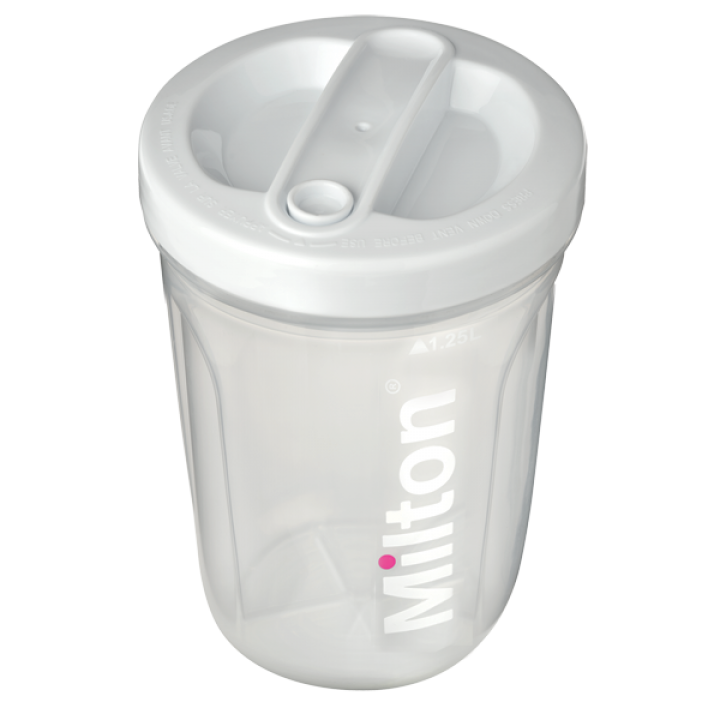
Key features
- 2 in 1 microwave or cold water Single bottle Steriliser
- Ideal for travel, overnight stays or when you’re away from home
- Sterilises from 2 minutes in the microwave and in 15 mins with cold water
- Unique safety vent technology to increase the temperature inside the Solo for better sterilisation
- Innovative lay-flat lip to fit all microwaves
- Contents stay sterile for 24 hours
Where to buy
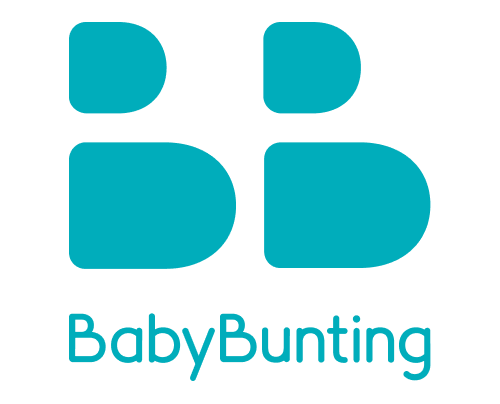
Put-in tours
Original tour agency in moscow and st petersburg..
Onboard a Soviet van!
Welcome to Russia!
We are Sergey and Simon, a Russian and a Frenchman, both passionate about Moscow, Saint-Petersburg and classic cars. Together, we have created Put-in tours. Our goal is to help you experience Russian culture off the beaten path. Join us onboard our classic Soviet van and let’s get rolling!
In Moscow we offer you a city tour to discover most of the city in an original way as well as a night tour to admire the lights. Our pubcrawl is ideal to explore Moscow’s night-life and have fun. If you are craving to discover Russian culture, come impress your senses during our monastery diner or join our 100% Russian Banya Excursion . The latest will also bring you to Sergiyev Posad and it’s famous monastery!
For the most extreme travellers, our shooting tour will deliver your daily dose of adrenaline whereas our tank excursion will let you ride a real tank and shoot a bazooka.
We also offer help to receive your visa , safe and multilingual airport transfers , as well as organisation services for team-building events or bachelor parties .
All our excursions (but the monastery diner) happen onboard our Soviet military vans and can be covered by our professionnal photographer or videographer.
In Saint Petersburg
We welcome you in Saint Petersburg onboard our Soviet van to discover the imperial city with our city tour and night tour .
Continue your discovery in style! The adrenaline lovers will like our shooting tour which brings 3 Russian weapons to the tip of your trigger finger.
Follow us on Social Media...
Our partners
© Copyright 2021 - Put-in tours Designed by SD Marketing & Design
At Put-in tours, we put you in our classic Soviet vans to go explore Moscow, Saint Petersburg and Russian culture off the beaten path. Discover our Moscow city guided tour, visit Moscow by night, join our banya & Sergiyev Posad excursion, visit and dine in one of Moscow's oldest monastery or even Luzhniki stadium, before you party on our famous pubcrawl! Original and atypical tours : Shoot AK47 and a bazooka after riding on a tank with our tank & bazooka excursion ! Extreme tours: Fly a fighter jet in Moscow onboard a L-29 or L-39 aircraft!
© Copyright 2021 – Put-in tours
Design web: SD Marketing & Design
Home About us Videos Moscow Saint-Petersburg Contact Online booking Blog Disclaimer Privacy Policy
WhatsApp us
2018 Primetime Emmy & James Beard Award Winner
In Transit: Notes from the Underground
Jun 06 2018.
Spend some time in one of Moscow’s finest museums.
Subterranean commuting might not be anyone’s idea of a good time, but even in a city packing the war-games treasures and priceless bejeweled eggs of the Kremlin Armoury and the colossal Soviet pavilions of the VDNKh , the Metro holds up as one of Moscow’s finest museums. Just avoid rush hour.
The Metro is stunning and provides an unrivaled insight into the city’s psyche, past and present, but it also happens to be the best way to get around. Moscow has Uber, and the Russian version called Yandex Taxi , but also some nasty traffic. Metro trains come around every 90 seconds or so, at a more than 99 percent on-time rate. It’s also reasonably priced, with a single ride at 55 cents (and cheaper in bulk). From history to tickets to rules — official and not — here’s what you need to know to get started.
A Brief Introduction Buying Tickets Know Before You Go (Down) Rules An Easy Tour
A Brief Introduction
Moscow’s Metro was a long time coming. Plans for rapid transit to relieve the city’s beleaguered tram system date back to the Imperial era, but a couple of wars and a revolution held up its development. Stalin revived it as part of his grand plan to modernize the Soviet Union in the 1920s and 30s. The first lines and tunnels were constructed with help from engineers from the London Underground, although Stalin’s secret police decided that they had learned too much about Moscow’s layout and had them arrested on espionage charges and deported.
The beauty of its stations (if not its trains) is well-documented, and certainly no accident. In its illustrious first phases and particularly after the Second World War, the greatest architects of Soviet era were recruited to create gleaming temples celebrating the Revolution, the USSR, and the war triumph. No two stations are exactly alike, and each of the classic showpieces has a theme. There are world-famous shrines to Futurist architecture, a celebration of electricity, tributes to individuals and regions of the former Soviet Union. Each marble slab, mosaic tile, or light fixture was placed with intent, all in service to a station’s aesthetic; each element, f rom the smallest brass ear of corn to a large blood-spattered sword on a World War II mural, is an essential part of the whole.

The Metro is a monument to the Soviet propaganda project it was intended to be when it opened in 1935 with the slogan “Building a Palace for the People”. It brought the grand interiors of Imperial Russia to ordinary Muscovites, celebrated the Soviet Union’s past achievements while promising its citizens a bright Soviet future, and of course, it was a show-piece for the world to witness the might and sophistication of life in the Soviet Union.
It may be a museum, but it’s no relic. U p to nine million people use it daily, more than the London Underground and New York Subway combined. (Along with, at one time, about 20 stray dogs that learned to commute on the Metro.)
In its 80+ year history, the Metro has expanded in phases and fits and starts, in step with the fortunes of Moscow and Russia. Now, partly in preparation for the World Cup 2018, it’s also modernizing. New trains allow passengers to walk the entire length of the train without having to change carriages. The system is becoming more visitor-friendly. (There are helpful stickers on the floor marking out the best selfie spots .) But there’s a price to modernity: it’s phasing out one of its beloved institutions, the escalator attendants. Often they are middle-aged or elderly women—“ escalator grandmas ” in news accounts—who have held the post for decades, sitting in their tiny kiosks, scolding commuters for bad escalator etiquette or even bad posture, or telling jokes . They are slated to be replaced, when at all, by members of the escalator maintenance staff.
For all its achievements, the Metro lags behind Moscow’s above-ground growth, as Russia’s capital sprawls ever outwards, generating some of the world’s worst traffic jams . But since 2011, the Metro has been in the middle of an ambitious and long-overdue enlargement; 60 new stations are opening by 2020. If all goes to plan, the 2011-2020 period will have brought 125 miles of new tracks and over 100 new stations — a 40 percent increase — the fastest and largest expansion phase in any period in the Metro’s history.
Facts: 14 lines Opening hours: 5 a.m-1 a.m. Rush hour(s): 8-10 a.m, 4-8 p.m. Single ride: 55₽ (about 85 cents) Wi-Fi network-wide

Buying Tickets
- Ticket machines have a button to switch to English.
- You can buy specific numbers of rides: 1, 2, 5, 11, 20, or 60. Hold up fingers to show how many rides you want to buy.
- There is also a 90-minute ticket , which gets you 1 trip on the metro plus an unlimited number of transfers on other transport (bus, tram, etc) within 90 minutes.
- Or, you can buy day tickets with unlimited rides: one day (218₽/ US$4), three days (415₽/US$7) or seven days (830₽/US$15). Check the rates here to stay up-to-date.
- If you’re going to be using the Metro regularly over a few days, it’s worth getting a Troika card , a contactless, refillable card you can use on all public transport. Using the Metro is cheaper with one of these: a single ride is 36₽, not 55₽. Buy them and refill them in the Metro stations, and they’re valid for 5 years, so you can keep it for next time. Or, if you have a lot of cash left on it when you leave, you can get it refunded at the Metro Service Centers at Ulitsa 1905 Goda, 25 or at Staraya Basmannaya 20, Building 1.
- You can also buy silicone bracelets and keychains with built-in transport chips that you can use as a Troika card. (A Moscow Metro Fitbit!) So far, you can only get these at the Pushkinskaya metro station Live Helpdesk and souvenir shops in the Mayakovskaya and Trubnaya metro stations. The fare is the same as for the Troika card.
- You can also use Apple Pay and Samsung Pay.
Rules, spoken and unspoken
No smoking, no drinking, no filming, no littering. Photography is allowed, although it used to be banned.
Stand to the right on the escalator. Break this rule and you risk the wrath of the legendary escalator attendants. (No shenanigans on the escalators in general.)
Get out of the way. Find an empty corner to hide in when you get off a train and need to stare at your phone. Watch out getting out of the train in general; when your train doors open, people tend to appear from nowhere or from behind ornate marble columns, walking full-speed.
Always offer your seat to elderly ladies (what are you, a monster?).
An Easy Tour
This is no Metro Marathon ( 199 stations in 20 hours ). It’s an easy tour, taking in most—though not all—of the notable stations, the bulk of it going clockwise along the Circle line, with a couple of short detours. These stations are within minutes of one another, and the whole tour should take about 1-2 hours.
Start at Mayakovskaya Metro station , at the corner of Tverskaya and Garden Ring, Triumfalnaya Square, Moskva, Russia, 125047.
1. Mayakovskaya. Named for Russian Futurist Movement poet Vladimir Mayakovsky and an attempt to bring to life the future he imagined in his poems. (The Futurist Movement, natch, was all about a rejecting the past and celebrating all things speed, industry, modern machines, youth, modernity.) The result: an Art Deco masterpiece that won the National Grand Prix for architecture at the New York World’s Fair in 1939. It’s all smooth, rounded shine and light, and gentle arches supported by columns of dark pink marble and stainless aircraft steel. Each of its 34 ceiling niches has a mosaic. During World War II, the station was used as an air-raid shelter and, at one point, a bunker for Stalin. He gave a subdued but rousing speech here in Nov. 6, 1941 as the Nazis bombed the city above.

Take the 3/Green line one station to:
2. Belorusskaya. Opened in 1952, named after the connected Belarussky Rail Terminal, which runs trains between Moscow and Belarus. This is a light marble affair with a white, cake-like ceiling, lined with Belorussian patterns and 12 Florentine ceiling mosaics depicting life in Belarussia when it was built.

Transfer onto the 1/Brown line. Then, one stop (clockwise) t o:
3. Novoslobodskaya. This station was designed around the stained-glass panels, which were made in Latvia, because Alexey Dushkin, the Soviet starchitect who dreamed it up (and also designed Mayakovskaya station) couldn’t find the glass and craft locally. The stained glass is the same used for Riga’s Cathedral, and the panels feature plants, flowers, members of the Soviet intelligentsia (musician, artist, architect) and geometric shapes.

Go two stops east on the 1/Circle line to:
4. Komsomolskaya. Named after the Komsomol, or the Young Communist League, this might just be peak Stalin Metro style. Underneath the hub for three regional railways, it was intended to be a grand gateway to Moscow and is today its busiest station. It has chandeliers; a yellow ceiling with Baroque embellishments; and in the main hall, a colossal red star overlaid on golden, shimmering tiles. Designer Alexey Shchusev designed it as an homage to the speech Stalin gave at Red Square on Nov. 7, 1941, in which he invoked Russia’s illustrious military leaders as a pep talk to Soviet soldiers through the first catastrophic year of the war. The station’s eight large mosaics are of the leaders referenced in the speech, such as Alexander Nevsky, a 13th-century prince and military commander who bested German and Swedish invading armies.

One more stop clockwise to Kurskaya station, and change onto the 3/Blue line, and go one stop to:
5. Baumanskaya. Opened in 1944. Named for the Bolshevik Revolutionary Nikolai Bauman , whose monument and namesake district are aboveground here. Though he seemed like a nasty piece of work (he apparently once publicly mocked a woman he had impregnated, who later hung herself), he became a Revolutionary martyr when he was killed in 1905 in a skirmish with a monarchist, who hit him on the head with part of a steel pipe. The station is in Art Deco style with atmospherically dim lighting, and a series of bronze sculptures of soldiers and homefront heroes during the War. At one end, there is a large mosaic portrait of Lenin.

Stay on that train direction one more east to:
6. Elektrozavodskaya. As you may have guessed from the name, this station is the Metro’s tribute to all thing electrical, built in 1944 and named after a nearby lightbulb factory. It has marble bas-relief sculptures of important figures in electrical engineering, and others illustrating the Soviet Union’s war-time struggles at home. The ceiling’s recurring rows of circular lamps give the station’s main tunnel a comforting glow, and a pleasing visual effect.

Double back two stops to Kurskaya station , and change back to the 1/Circle line. Sit tight for six stations to:
7. Kiyevskaya. This was the last station on the Circle line to be built, in 1954, completed under Nikita Khrushchev’ s guidance, as a tribute to his homeland, Ukraine. Its three large station halls feature images celebrating Ukraine’s contributions to the Soviet Union and Russo-Ukrainian unity, depicting musicians, textile-working, soldiers, farmers. (One hall has frescoes, one mosaics, and the third murals.) Shortly after it was completed, Khrushchev condemned the architectural excesses and unnecessary luxury of the Stalin era, which ushered in an epoch of more austere Metro stations. According to the legend at least, he timed the policy in part to ensure no Metro station built after could outshine Kiyevskaya.

Change to the 3/Blue line and go one stop west.
8. Park Pobedy. This is the deepest station on the Metro, with one of the world’s longest escalators, at 413 feet. If you stand still, the escalator ride to the surface takes about three minutes .) Opened in 2003 at Victory Park, the station celebrates two of Russia’s great military victories. Each end has a mural by Georgian artist Zurab Tsereteli, who also designed the “ Good Defeats Evil ” statue at the UN headquarters in New York. One mural depicts the Russian generals’ victory over the French in 1812 and the other, the German surrender of 1945. The latter is particularly striking; equal parts dramatic, triumphant, and gruesome. To the side, Red Army soldiers trample Nazi flags, and if you look closely there’s some blood spatter among the detail. Still, the biggest impressions here are the marble shine of the chessboard floor pattern and the pleasingly geometric effect if you view from one end to the other.

Keep going one more stop west to:
9. Slavyansky Bulvar. One of the Metro’s youngest stations, it opened in 2008. With far higher ceilings than many other stations—which tend to have covered central tunnels on the platforms—it has an “open-air” feel (or as close to it as you can get, one hundred feet under). It’s an homage to French architect Hector Guimard, he of the Art Nouveau entrances for the Paris M é tro, and that’s precisely what this looks like: A Moscow homage to the Paris M é tro, with an additional forest theme. A Cyrillic twist on Guimard’s Metro-style lettering over the benches, furnished with t rees and branch motifs, including creeping vines as towering lamp-posts.

Stay on the 3/Blue line and double back four stations to:
10. Arbatskaya. Its first iteration, Arbatskaya-Smolenskaya station, was damaged by German bombs in 1941. It was rebuilt in 1953, and designed to double as a bomb shelter in the event of nuclear war, although unusually for stations built in the post-war phase, this one doesn’t have a war theme. It may also be one of the system’s most elegant: Baroque, but toned down a little, with red marble floors and white ceilings with gilded bronze c handeliers.

Jump back on the 3/Blue line in the same direction and take it one more stop:
11. Ploshchad Revolyutsii (Revolution Square). Opened in 1938, and serving Red Square and the Kremlin . Its renowned central hall has marble columns flanked by 76 bronze statues of Soviet heroes: soldiers, students, farmers, athletes, writers, parents. Some of these statues’ appendages have a yellow sheen from decades of Moscow’s commuters rubbing them for good luck. Among the most popular for a superstitious walk-by rub: the snout of a frontier guard’s dog, a soldier’s gun (where the touch of millions of human hands have tapered the gun barrel into a fine, pointy blade), a baby’s foot, and a woman’s knee. (A brass rooster also sports the telltale gold sheen, though I am told that rubbing the rooster is thought to bring bad luck. )
Now take the escalator up, and get some fresh air.

R&K Insider
Join our newsletter to get exclusives on where our correspondents travel, what they eat, where they stay. Free to sign up.
21 Things to Know Before You Go to Moscow
Featured city guides.

IMAGES
VIDEO
COMMENTS
Dr. Brown's Microwave Steam Sterilizer Bags for Baby Bottles, Pacifiers, Pump Parts and Accessories, Travel Baby Bottle Sterilizer, 30 Uses per Bag, 5-Pack ... Travel Baby Bottle Sterilizer, 30 Uses per Bag, 5-Pack. 5 Count (Pack of 1) 4.8 out of 5 stars. 4,414. 6K+ bought in past month. $5.99 $ 5. 99. List: $9.99 $9.99. FREE delivery Mon, May ...
Best Drying: Wabi Baby Electric Steam Sterilizer and Dryer. Best with Bottle Warmer: Dr. Brown's Deluxe Bottle Warmer & Sterilizer. Best Budget: Munchkin Steam Microwave Bottle Sterilizer. Best ...
Best Overall Bottle Sterilizer: Baby Brezza One Step Sterilizer Dryer. Best Value Bottle Sterilizer: Munchkin Steam Microwave Sterilizer. Best Microwavable Bottle Sterilizer: Philips Avent ...
Chicco Baby Bottle Steam Sterilizer 3-in-1. Having trouble finding a versatile bottle sterilizer for home and travel? Check out the Chicco Baby Bottle Steam Sterilizer. This 3-in-1 sterilizer offers three modes: full-size, compact, and microwave settings. In about 5 minutes, it can clean up to 6 bottles and smaller accessories in full-size mode.
We tested bottle sterilizers from Baby Brezza, Hauture, Papablic, and other brands to find the ones that are easiest to use and most effective in getting bottles clean. By Molly Bradley. Updated ...
Most Spacious Bottle Sterilizer: Dr. Brown's Electric Steam Sterilizer. Best for On-the-Go Sterilizing: Munchkin Jumbo Microwave Bottle Sterilizer Bags. Best Compact Bottle Sterilizer: Chicco 3-in-1 Steam Sterilizer. Best Portable Sterilizer for Small Parts: Munchkin Mini Portable UV Sterilizer.
Learn More. Amazon. Best Bottle Sterilizer and Warmer. Dr. Brown's Deluxe Bottle Warmer & Sterilizer. $49. Learn More. Amazon. As you make your baby registry, you might find yourself debating whether you really need certain items. One of the items in question: a baby bottle sterilizer.
Best sterilisers at a glance. Best overall steriliser: Tommee Tippee Super Steam Advanced Electric Steriliser. Best budget steriliser: Medela Quick Clean Microwave Bags. Best cold water steriliser: Milton Cold Water Steriliser. Best travel steriliser: Milton Solo Travel Steriliser. Best large steriliser: Dr Brown's Deluxe Electric Steam ...
Dr. Brown's All-in-One Sterilizer & Dryer for Baby Bottles and Newborn Essentials. Dr. Brown's. 292. $79.99. When purchased online. Add to cart. nanobebe Baby Bottles Sippy Cups & Accessories Microwave Steam Sterilizer. nanobebe. 38.
The Centers for Disease Control and Prevention (CDC) recommends sanitizing feeding items Opens a new window at least once a day, especially if your baby is younger than 2 months, has a weakened immune system, or was born prematurely. Sanitizing may not be necessary for healthy older babies if bottles and other feeding supplies are cleaned after use.
Check Price. This 3-in-1 sterilizer kills 99.9 percent of harmful germs and bacteria on bottles without using any chemicals that could harm your little one. It has an adjustable modular design so you can fit a variety of bottles or nursing accessories inside. At most, it fits up to six 11-ounce bottles.
MAM Electric Baby Bottle Steriliser & Express Bottle Warmer. £115.20, Boots. Best overall, 9/10. ... Nuby UV Portable Baby Bottle Steriliser. £132, Boots. Best travel steriliser, 9/10.
Best for Travel: Chicco Digital Bottle Warmer & Sterilizer ». Jump to Review ↓. Best for Speed Sterilization: Babymoov Turbo Pure 3-in-1 Steriliser, Dryer & Purified Bottle Storage ». Jump to ...
Best Large Capacity Bottle Sterilizer: Chicco Advanced Electric Steam Sterilizer And Dryer. Fastest Bottle Sterilizer: Baby Brezza Superfast Sterilizer Dryer. Best Combination Bottle Sterilizer ...
2 in 1 microwave or cold water Single bottle Steriliser. Ideal for travel, overnight stays or when you're away from home. Sterilises from 2 minutes in the microwave and in 15 mins with cold water. Unique safety vent technology to increase the temperature inside the Solo for better sterilisation. Innovative lay-flat lip to fit all microwaves.
0 likes, 0 comments - thebabycentre2024 on April 15, 2024: "In Stock!! Dr. Brown's Microwave Steam Sterilizer Bags for Baby Bottles, Pacifiers, Pump Parts and ...
In Moscow. In Moscow we offer you a city tour to discover most of the city in an original way as well as a night tour to admire the lights. Our pubcrawl is ideal to explore Moscow's night-life and have fun. If you are craving to discover Russian culture, come impress your senses during our monastery diner or join our 100% Russian Banya Excursion.The latest will also bring you to Sergiyev ...
Our goal - is to provide Russian customers the new high-quality, innovative and unique products of well-known foreign brands for kids and their parents. Key areas of our business: 1. Baby hygiene (diapers, wipes, nappies) 2. Feeding (bottles and pacifiers, high chairs, sterilizers) 3. Toys (educational, bathroom, bassinet)
Trekhprudny Per. 15; 00 7 495 699 214. • A complete guide to the best hotels in Moscow. For Fedoskino lacquer boxes, head 20 miles outside of Moscow where you can visit the Fedoskino factory ...
Just avoid rush hour. The Metro is stunning andprovides an unrivaled insight into the city's psyche, past and present, but it also happens to be the best way to get around. Moscow has Uber, and the Russian version called Yandex Taxi,butalso some nasty traffic. Metro trains come around every 90 seconds or so, at a more than 99 percent on-time ...